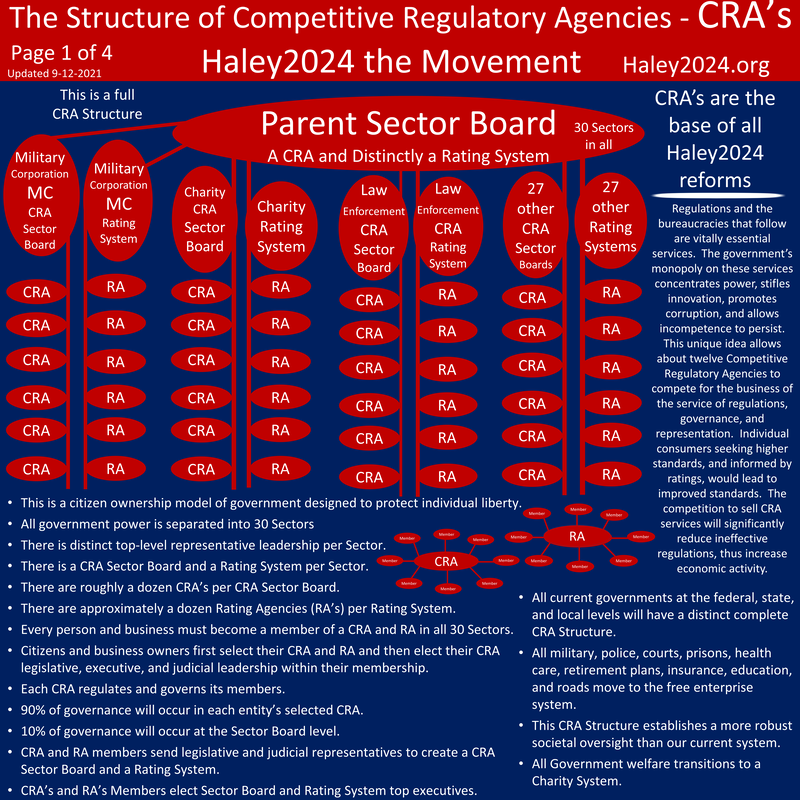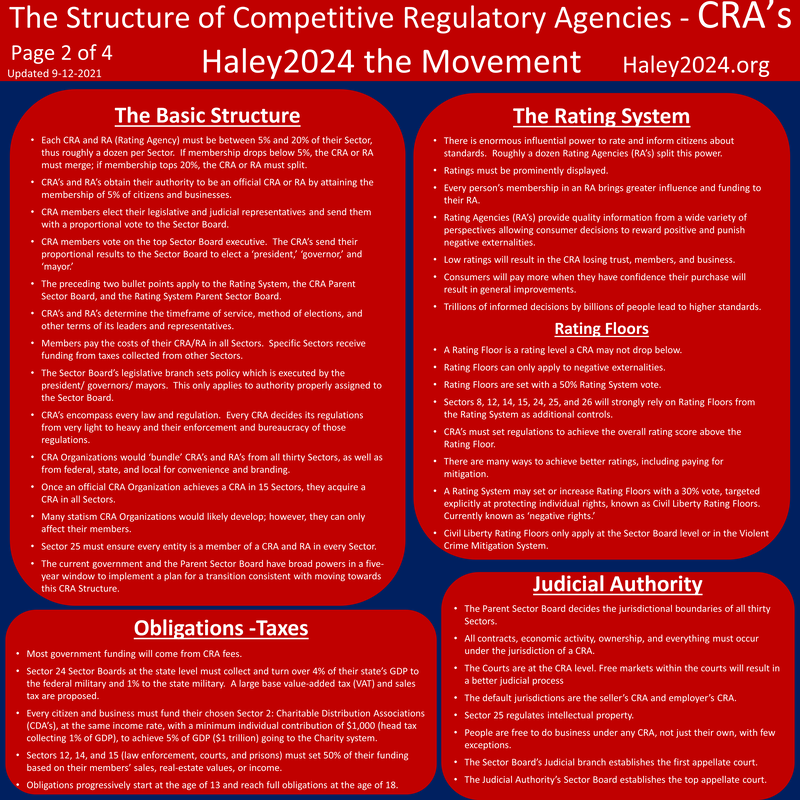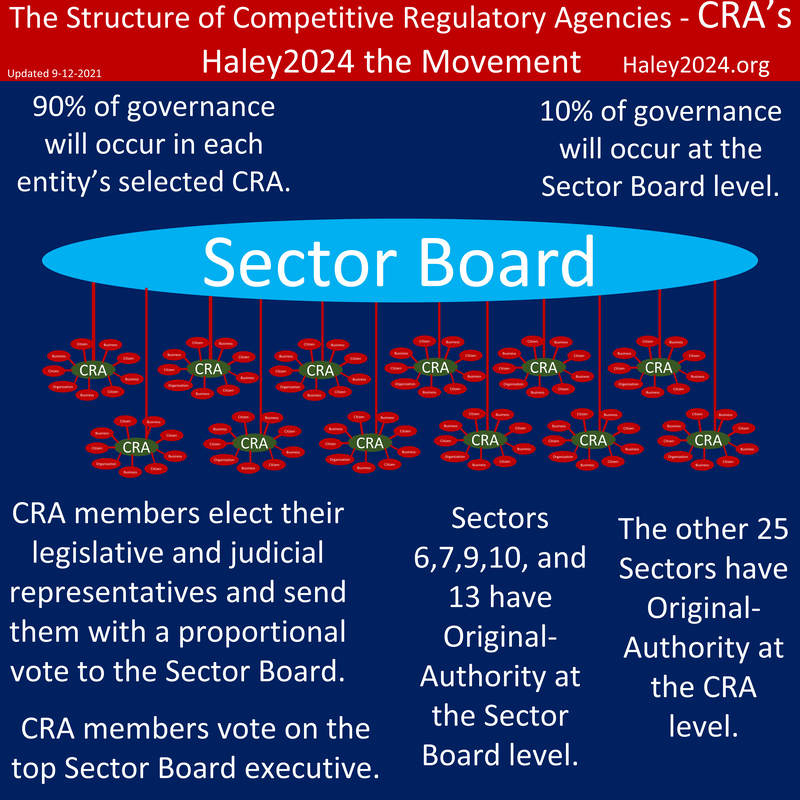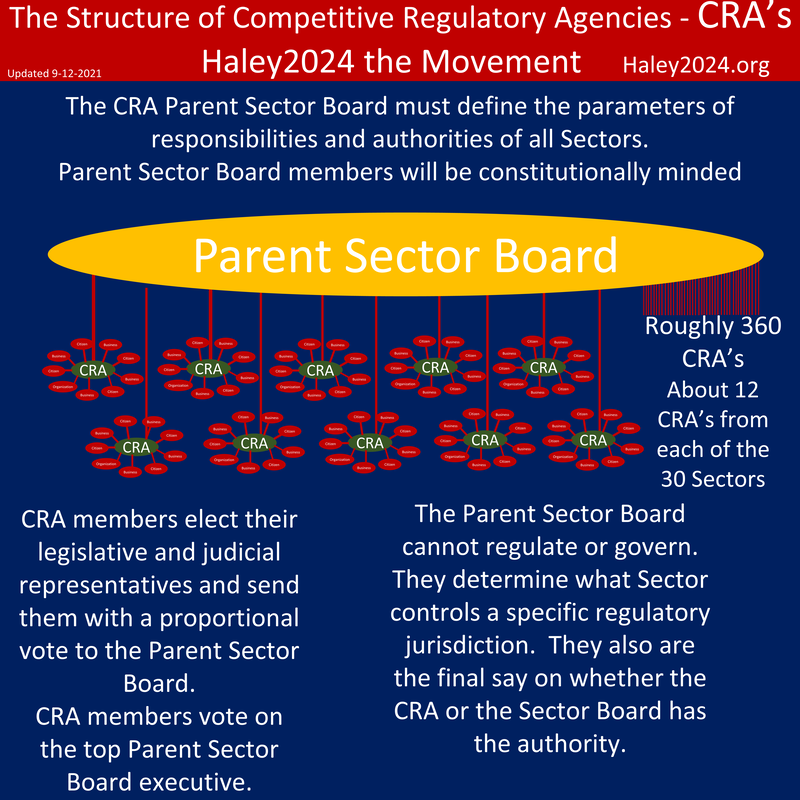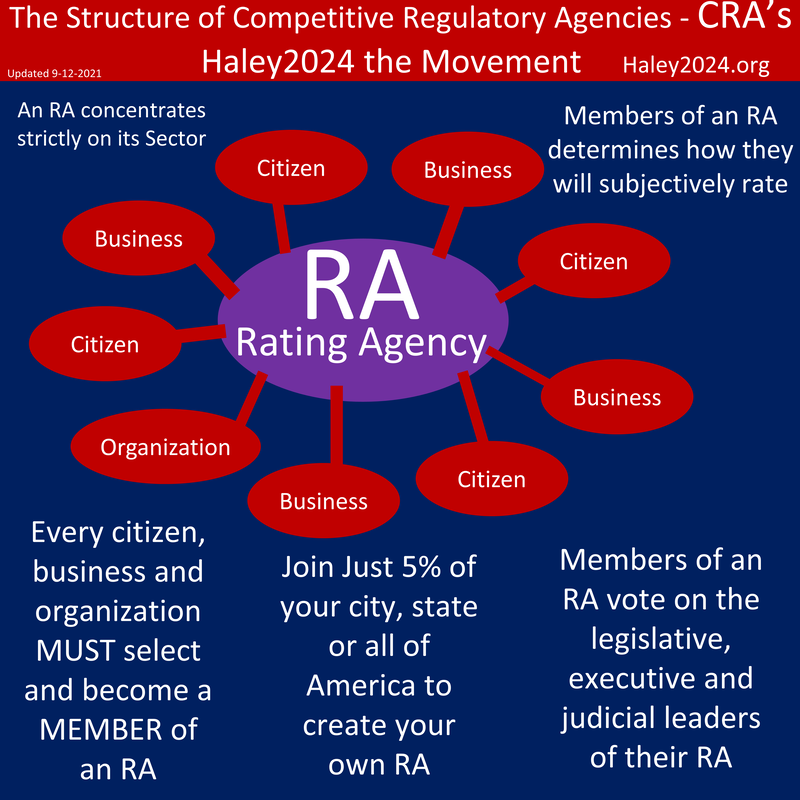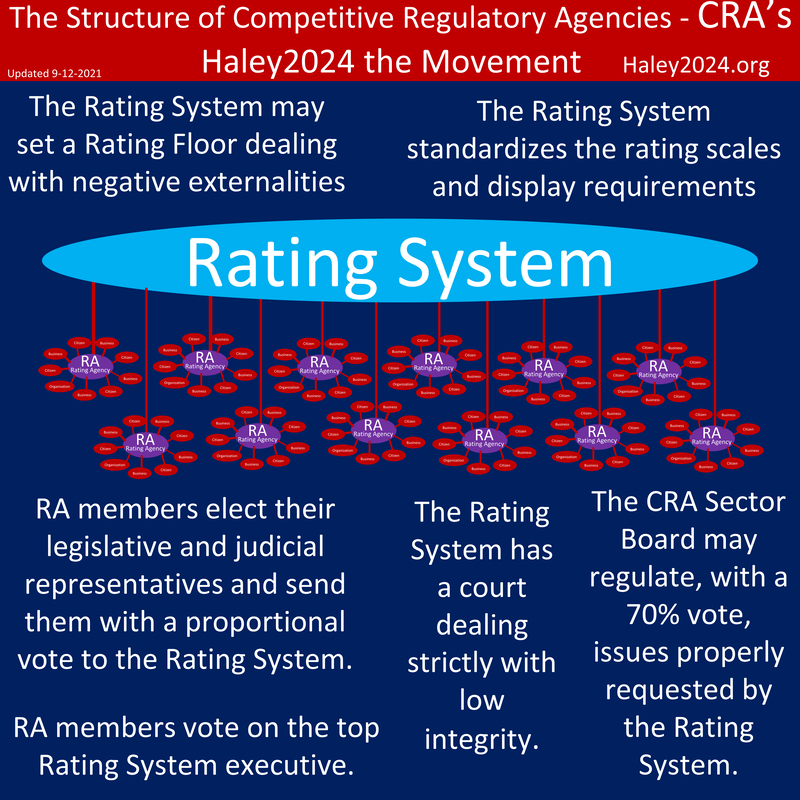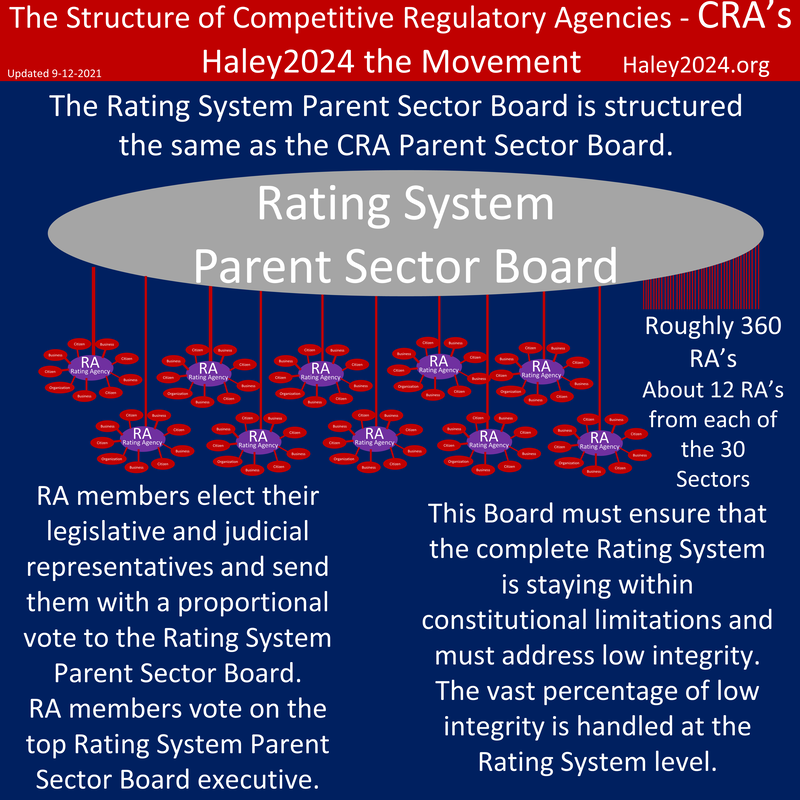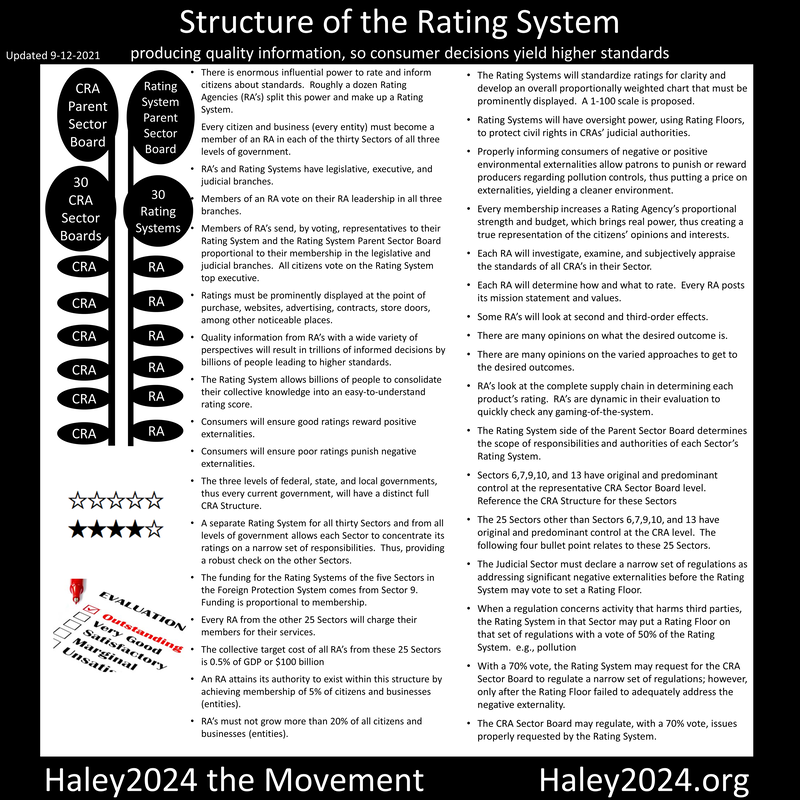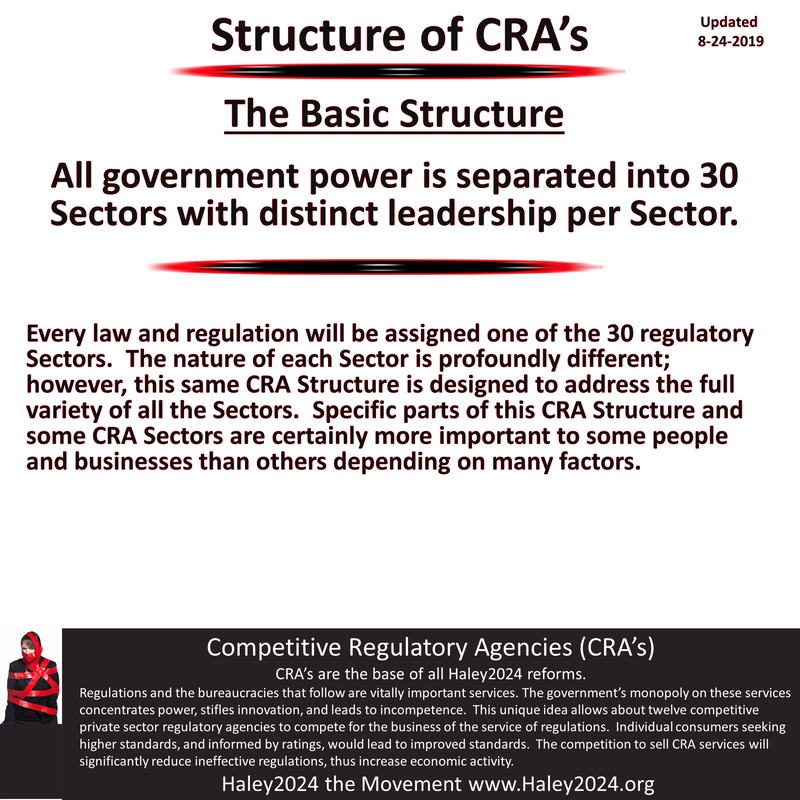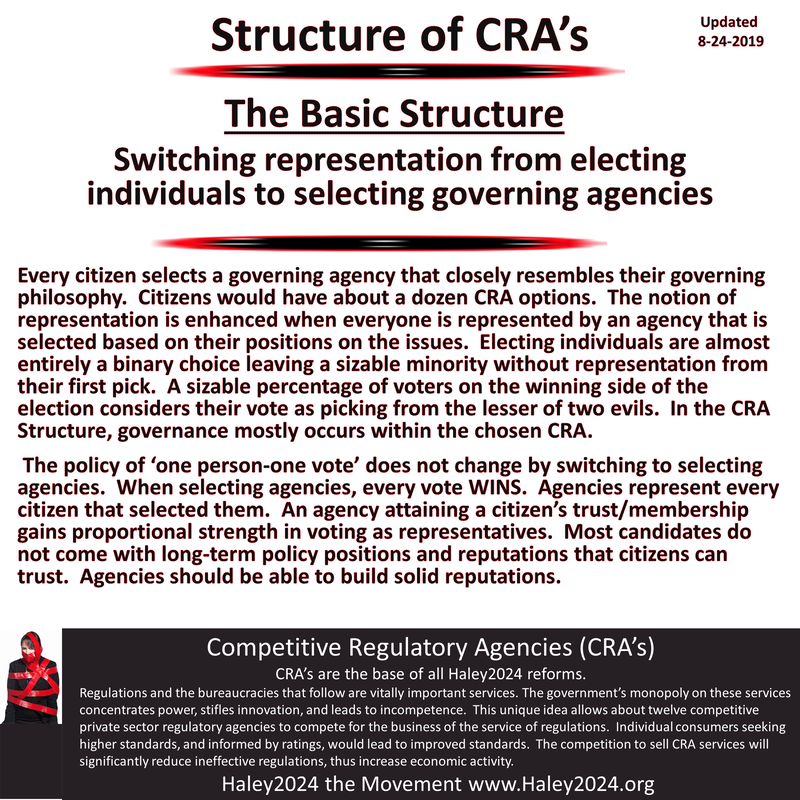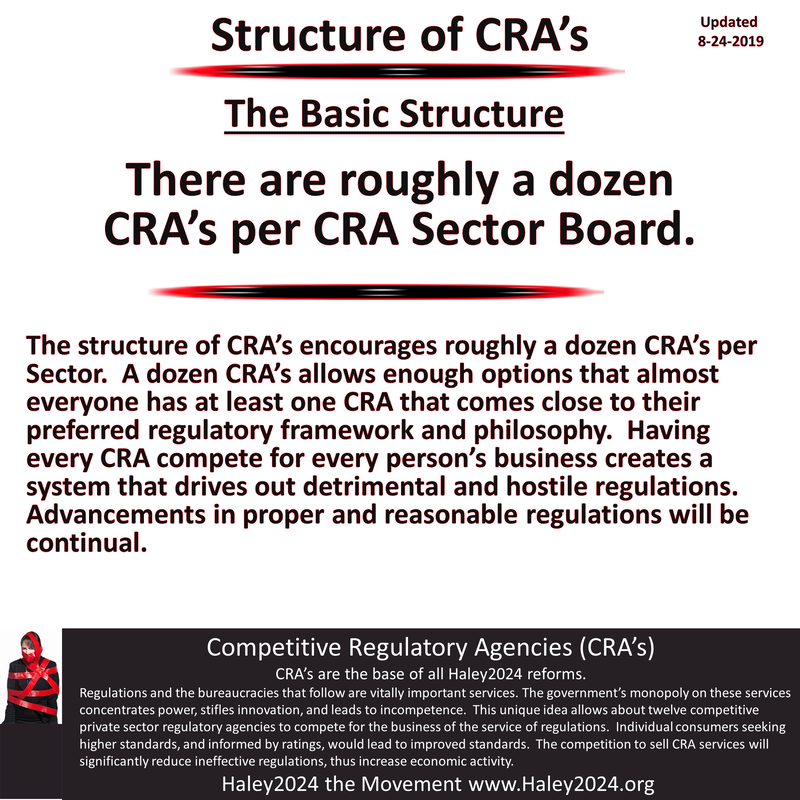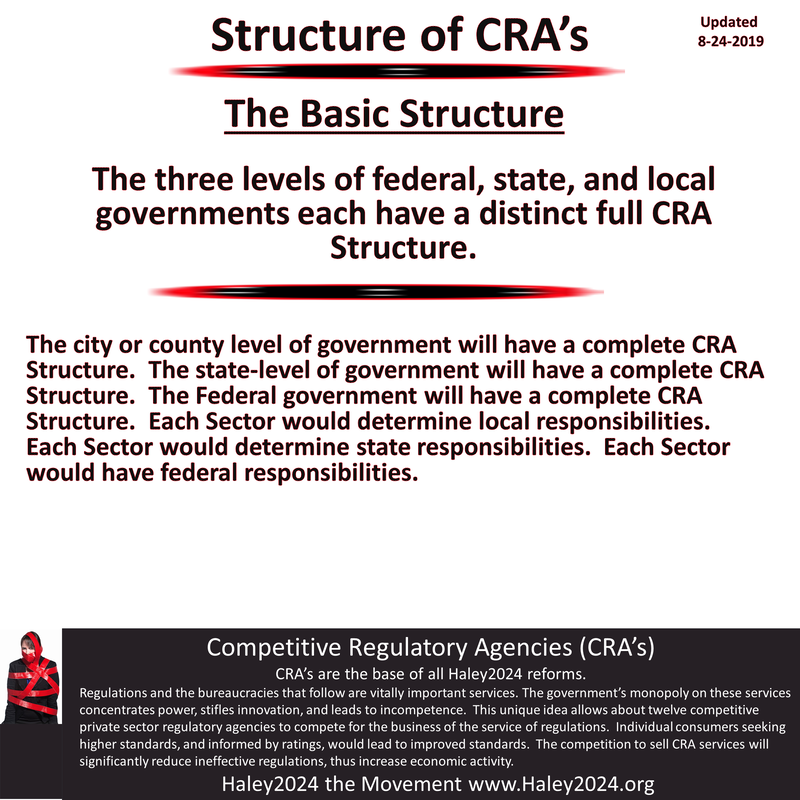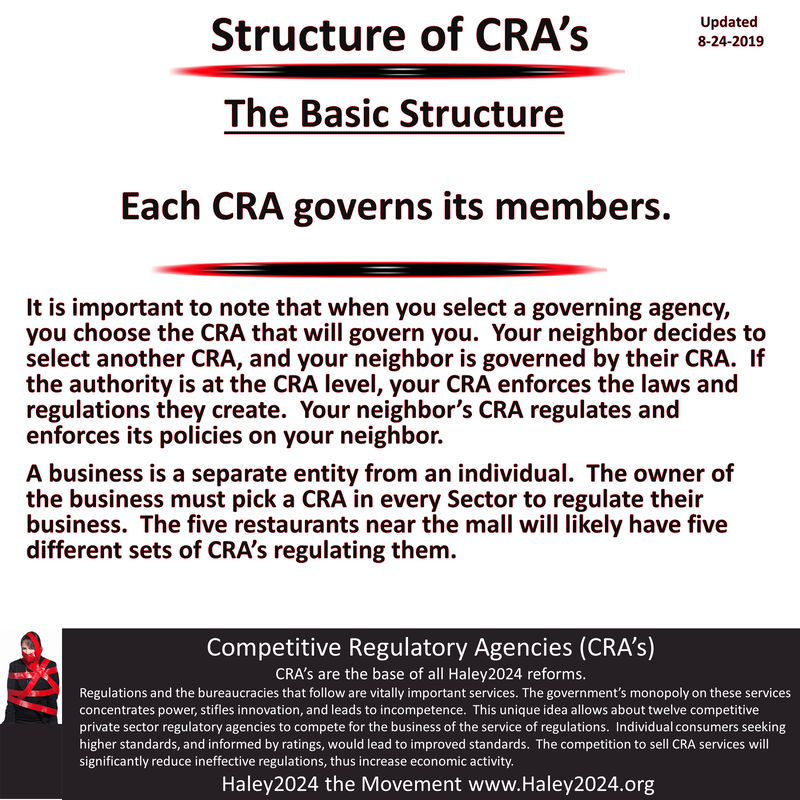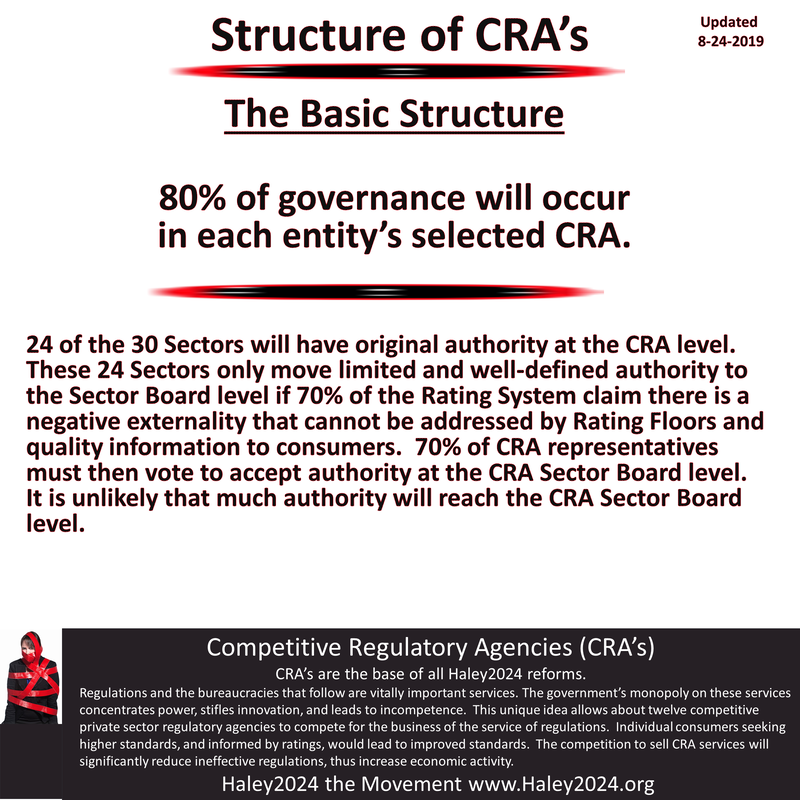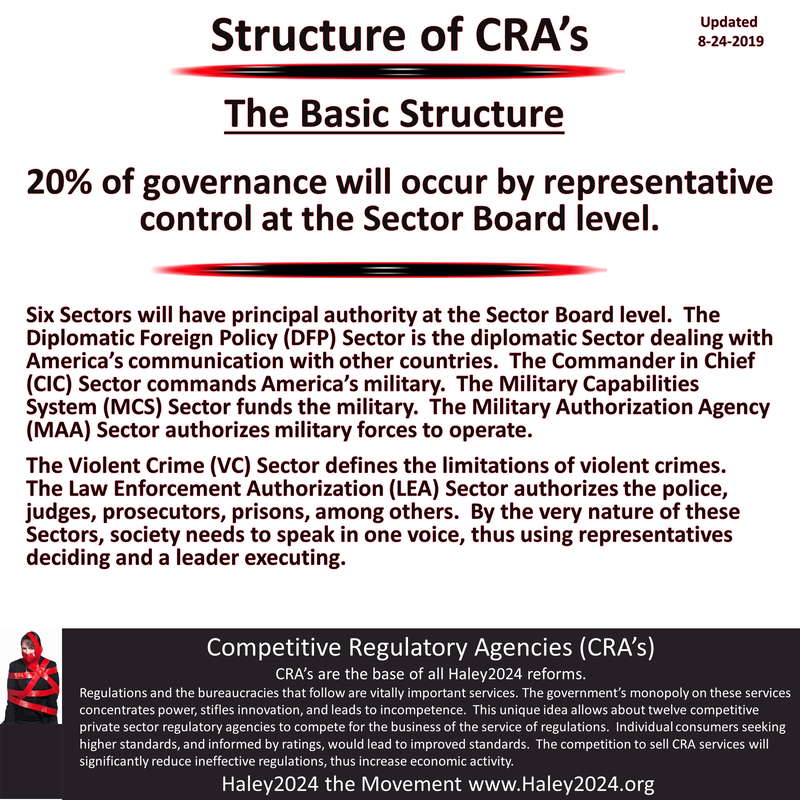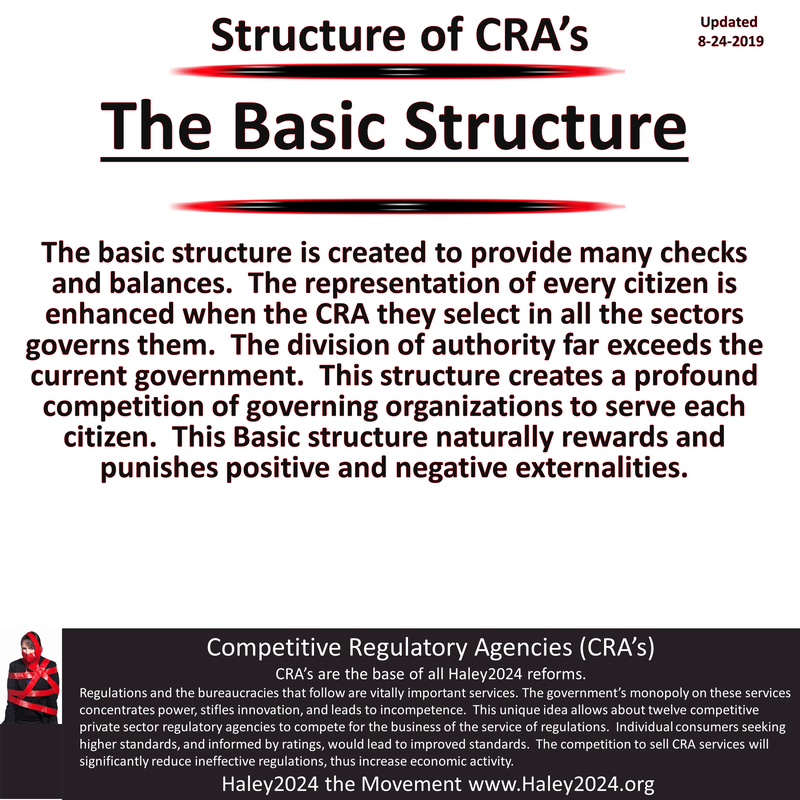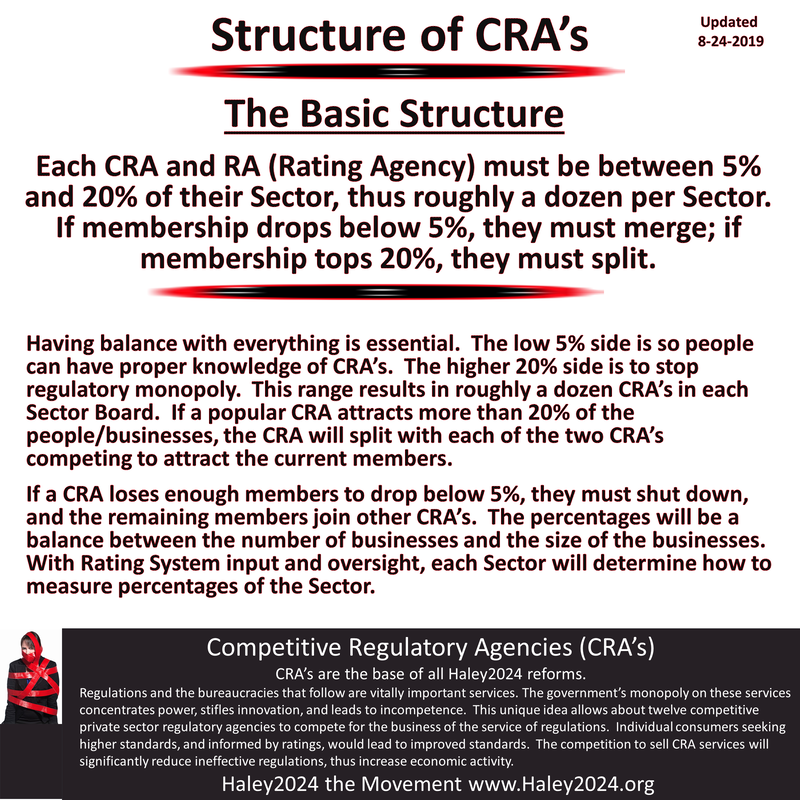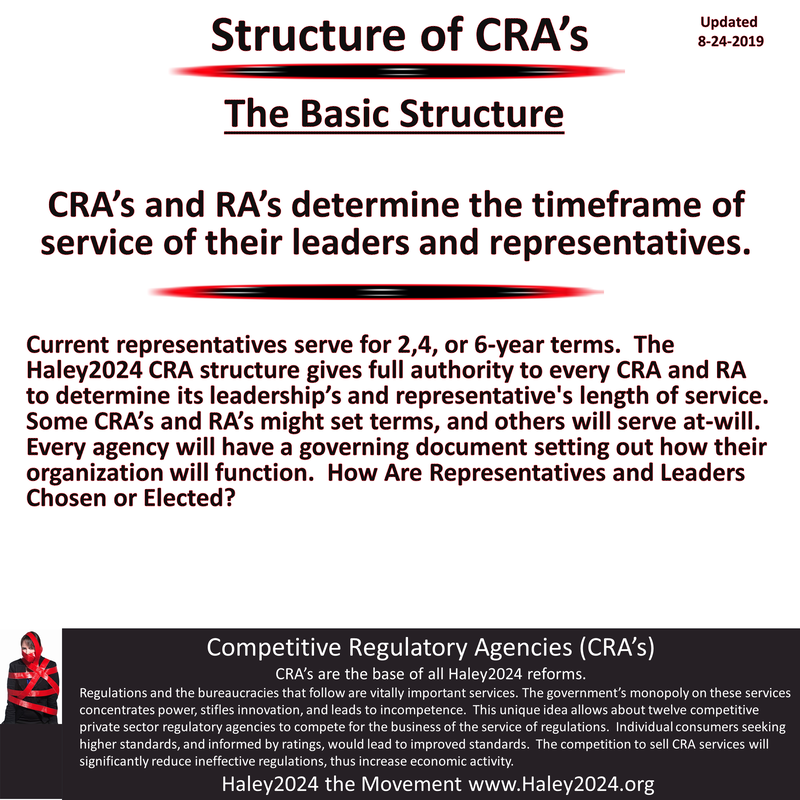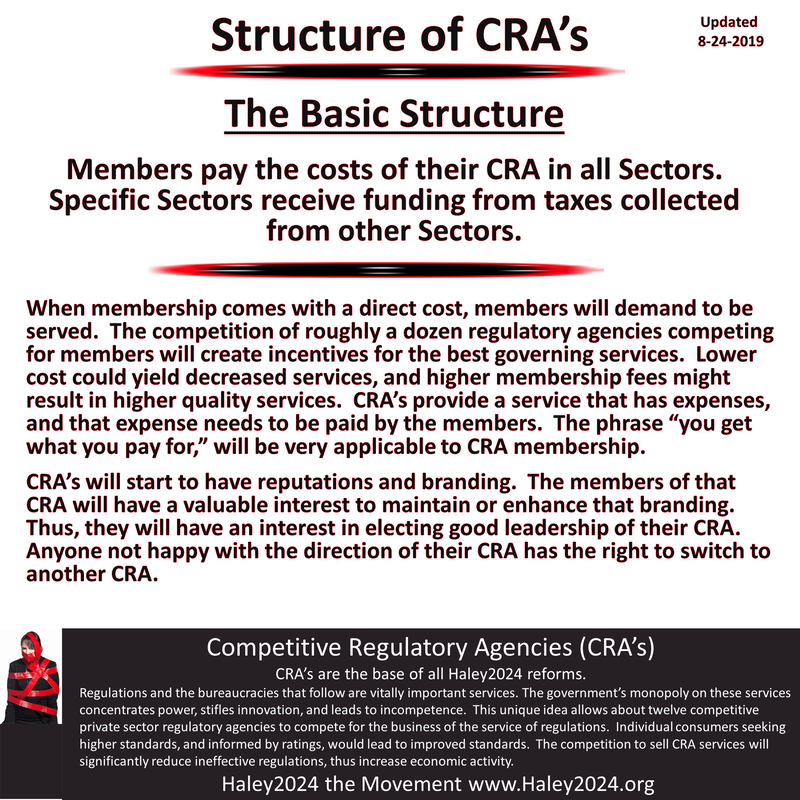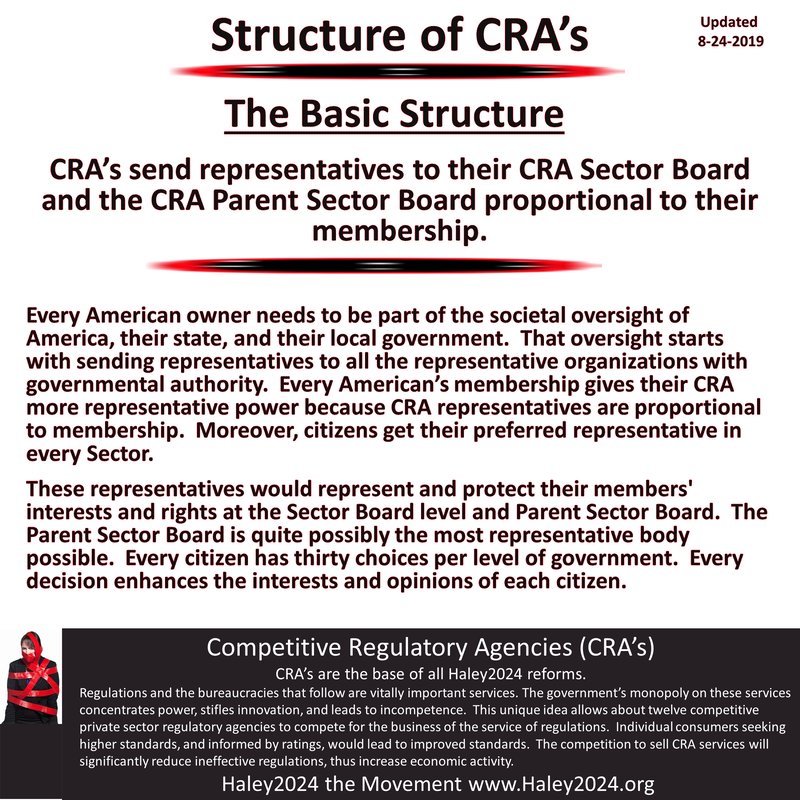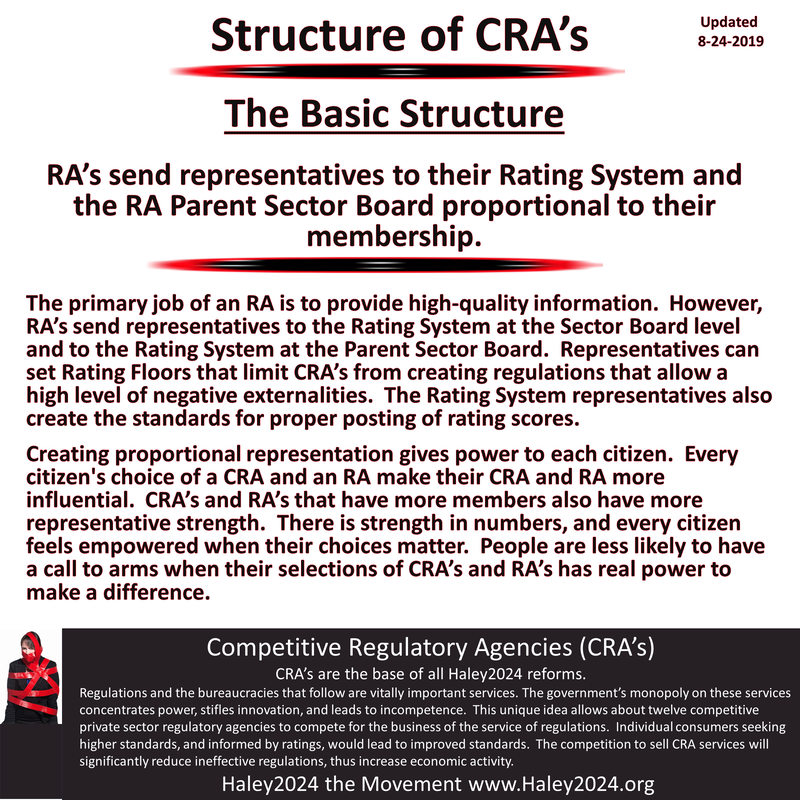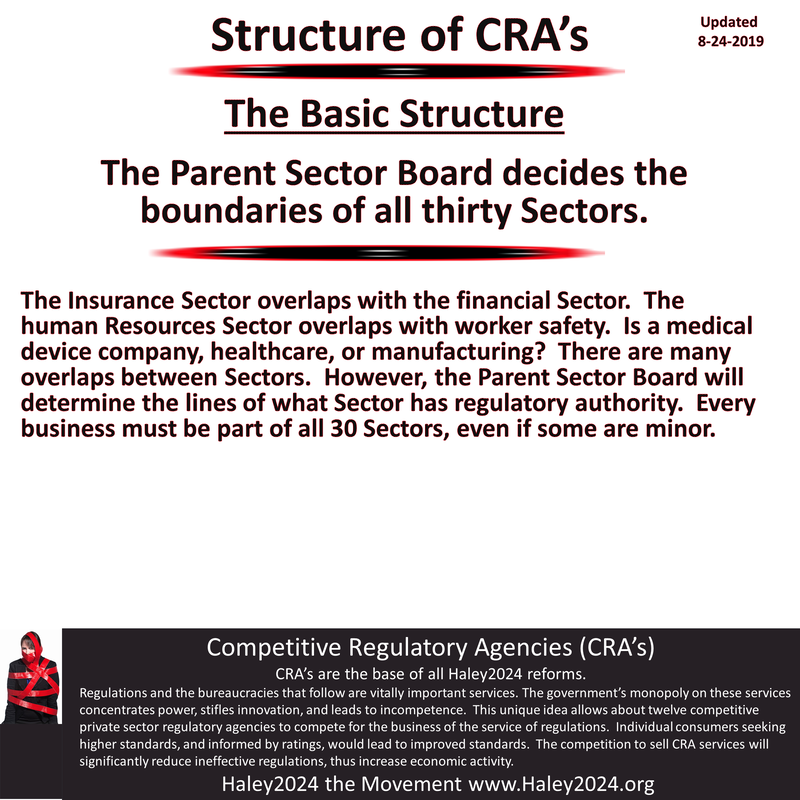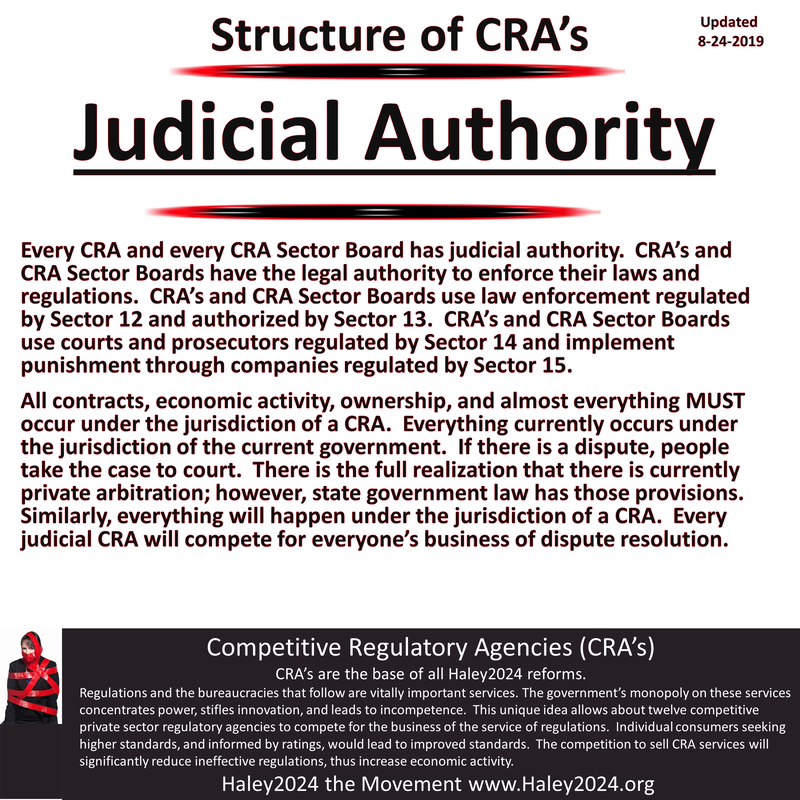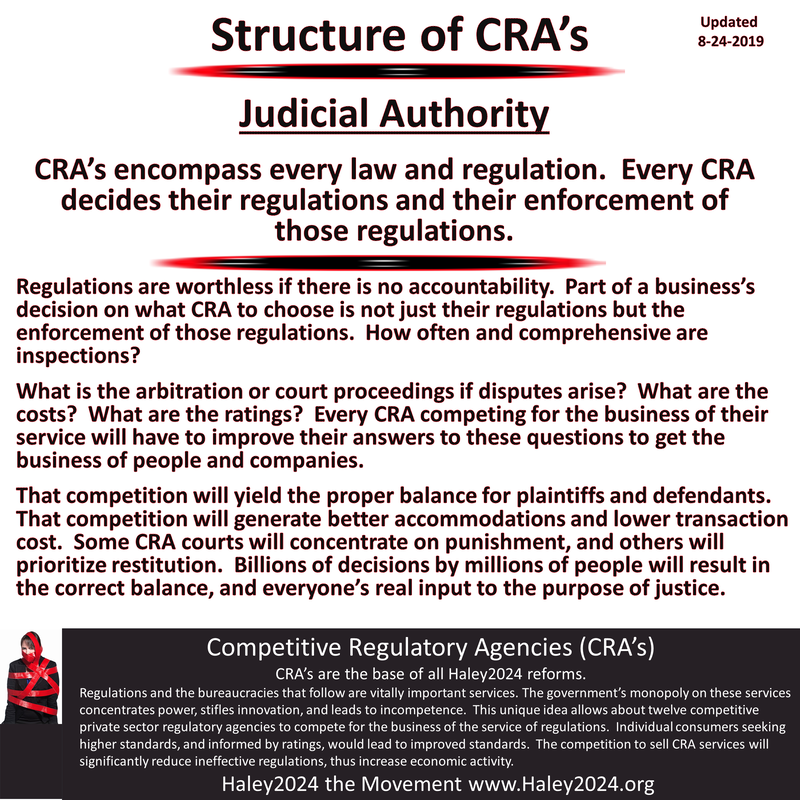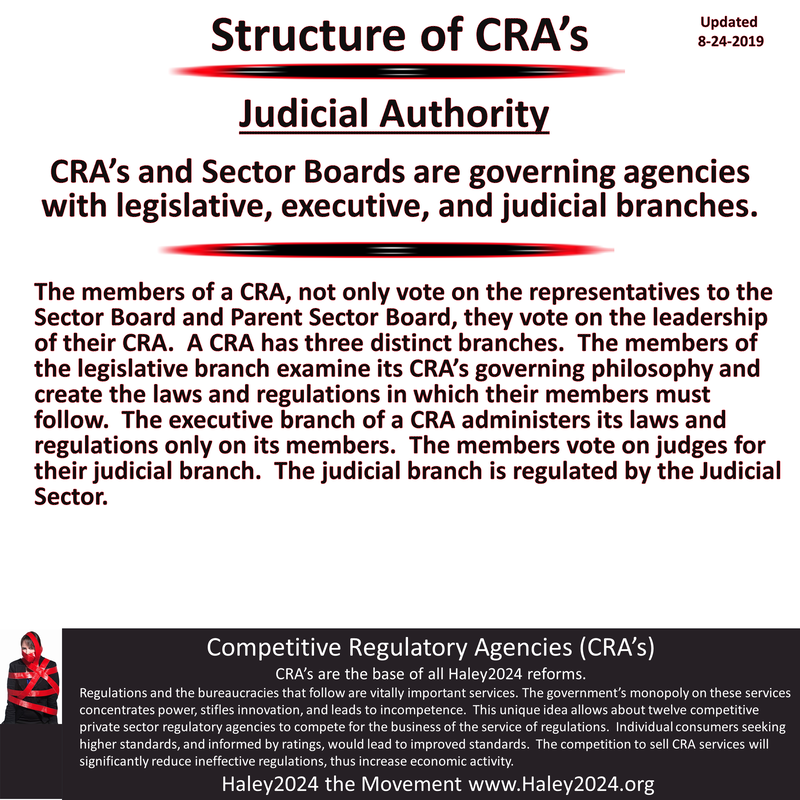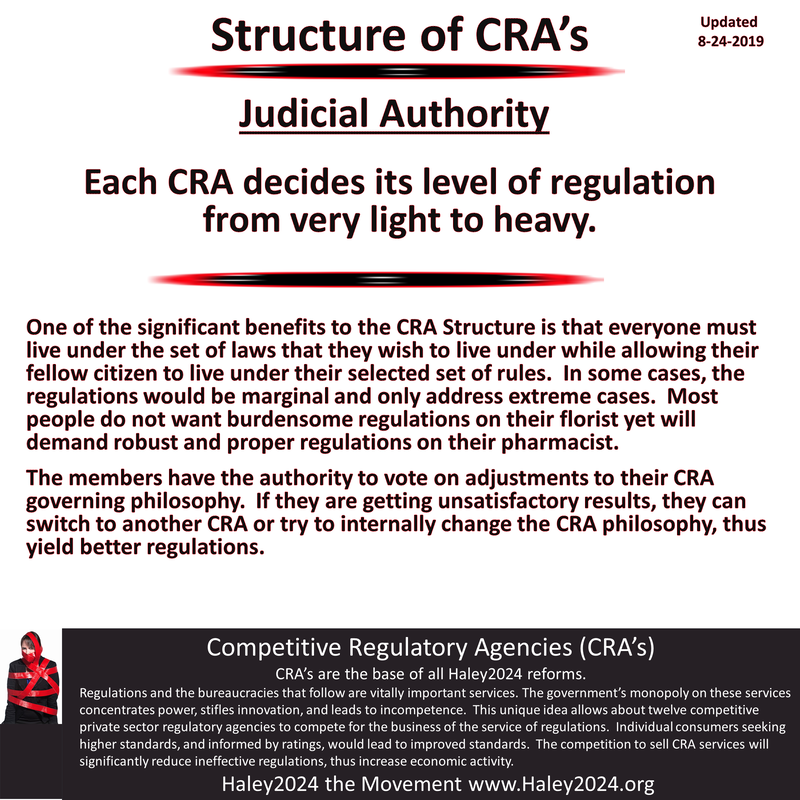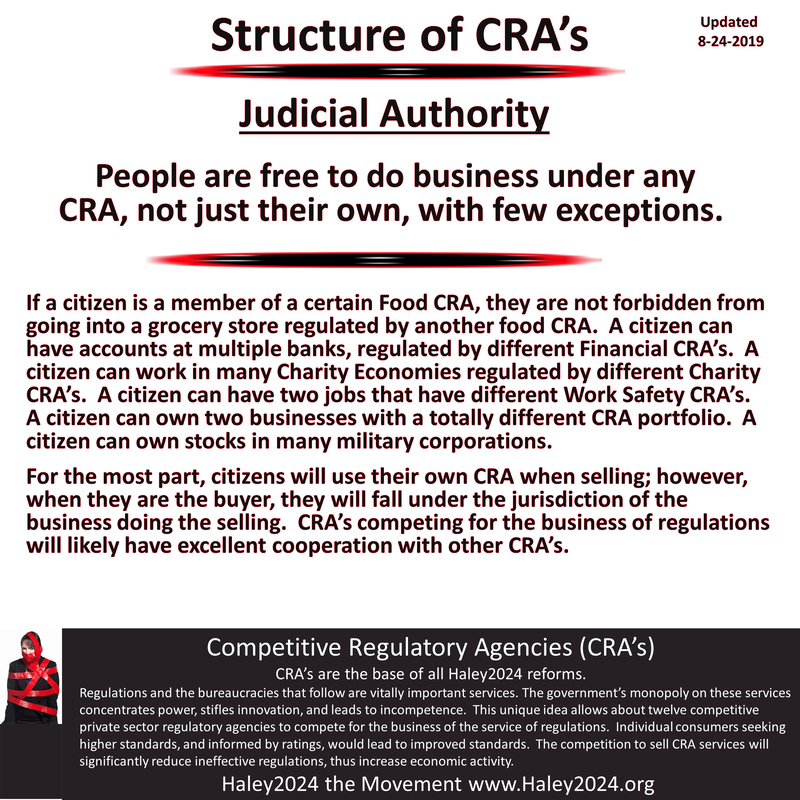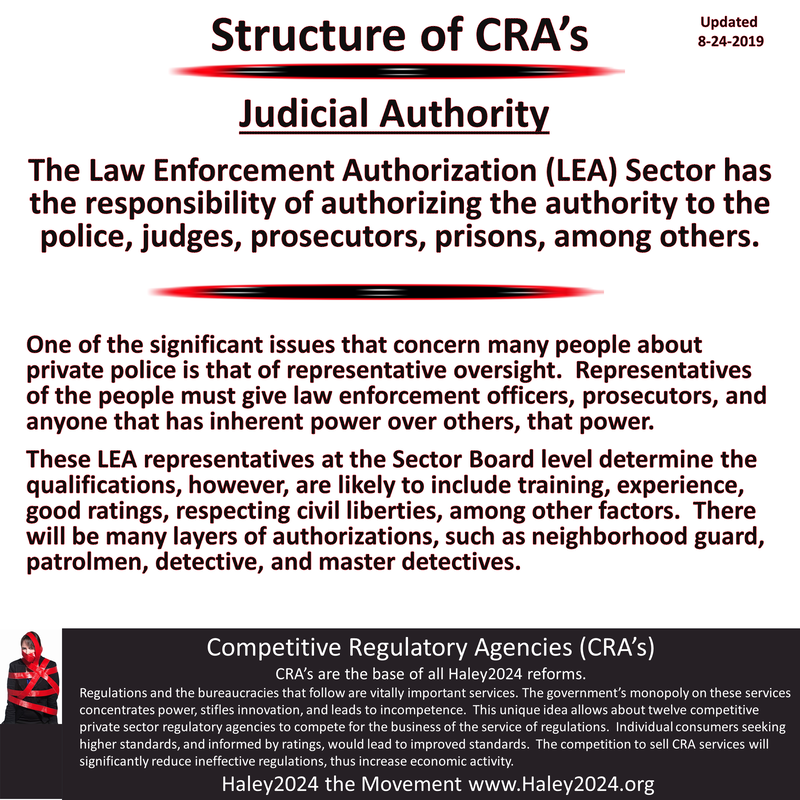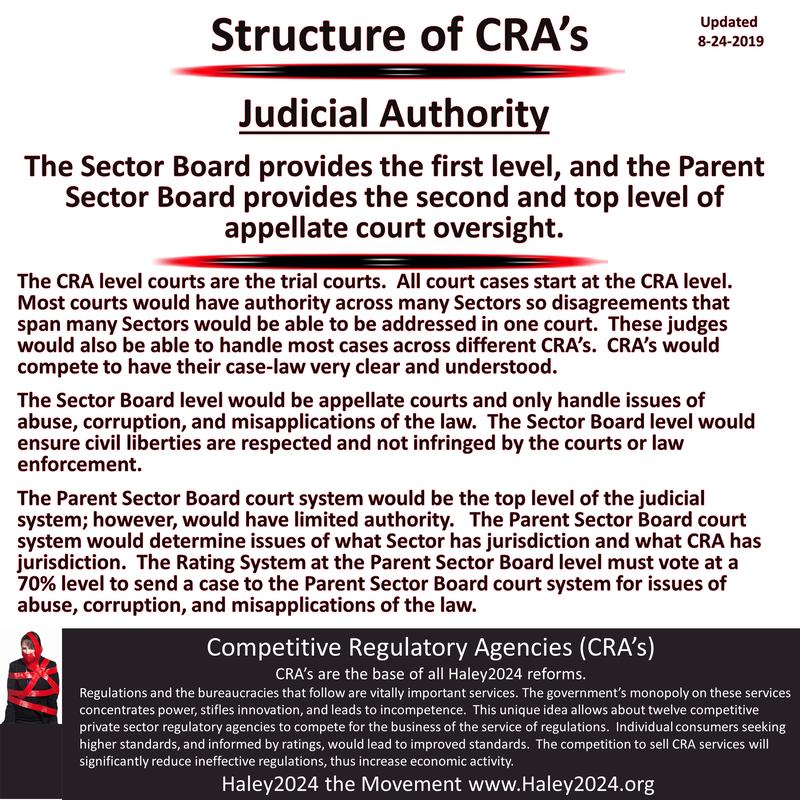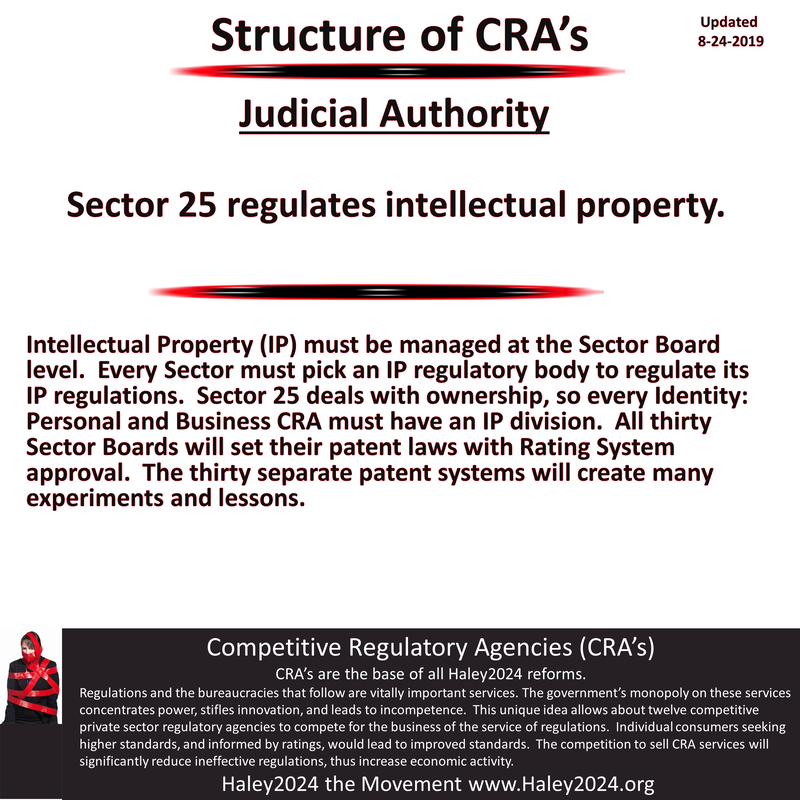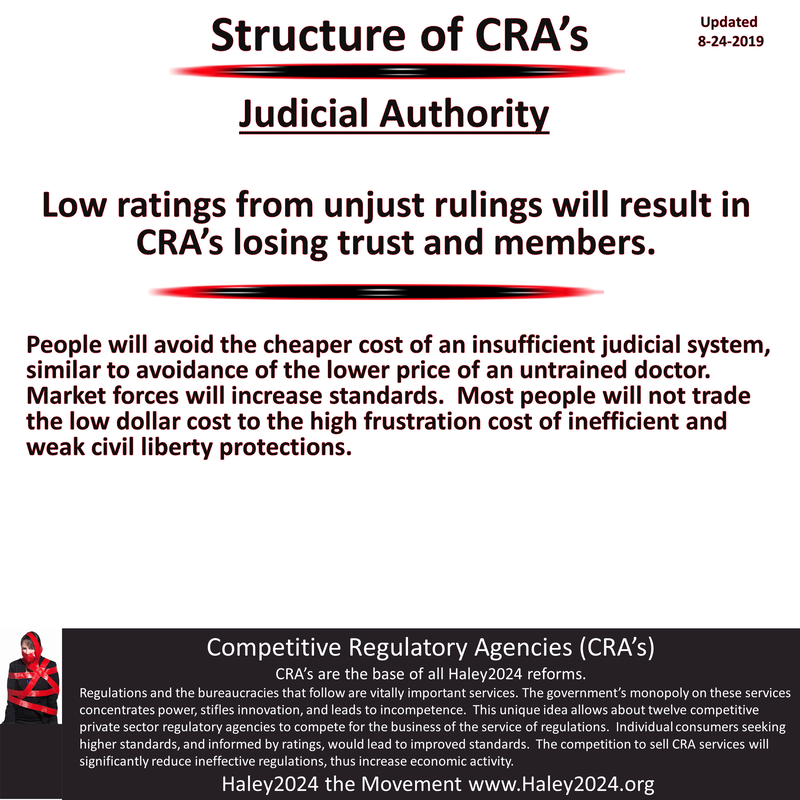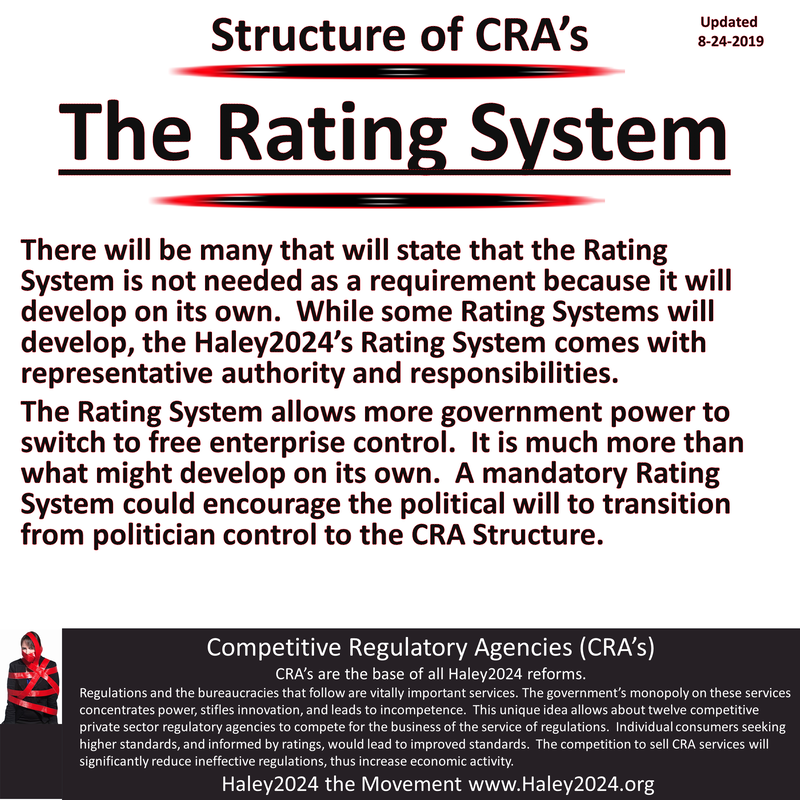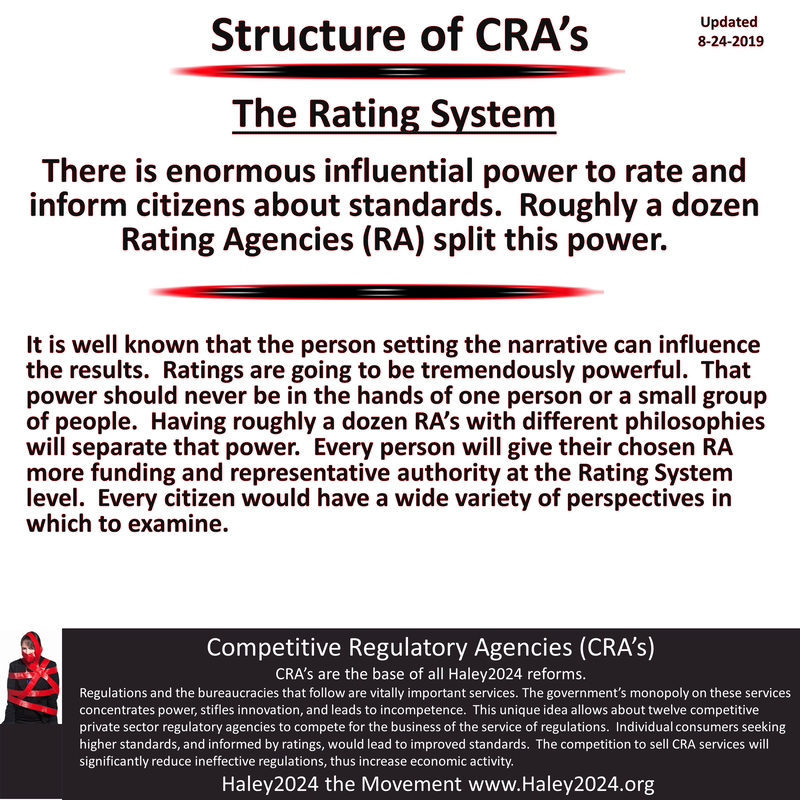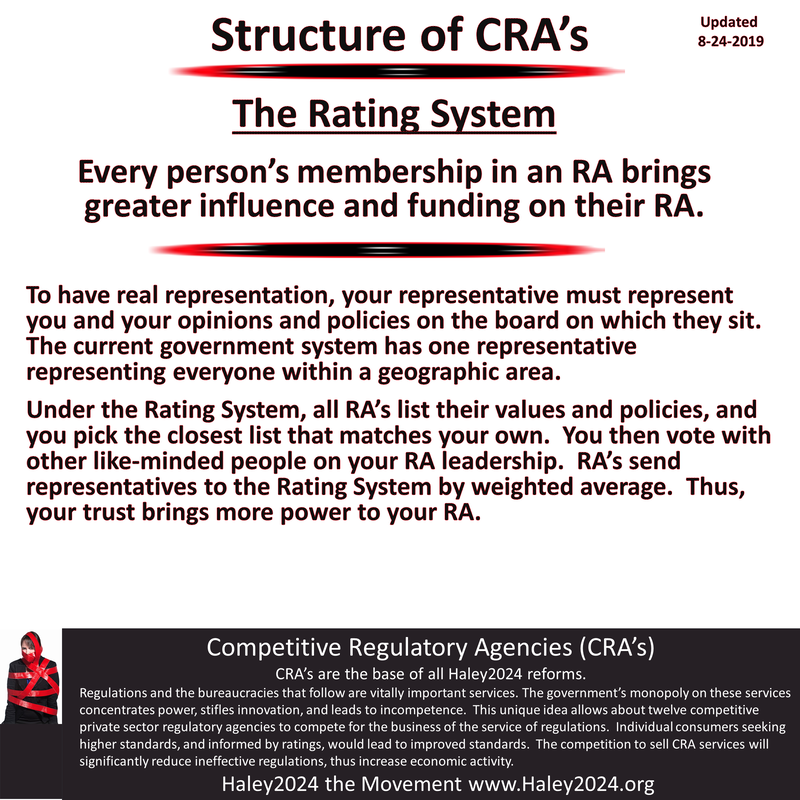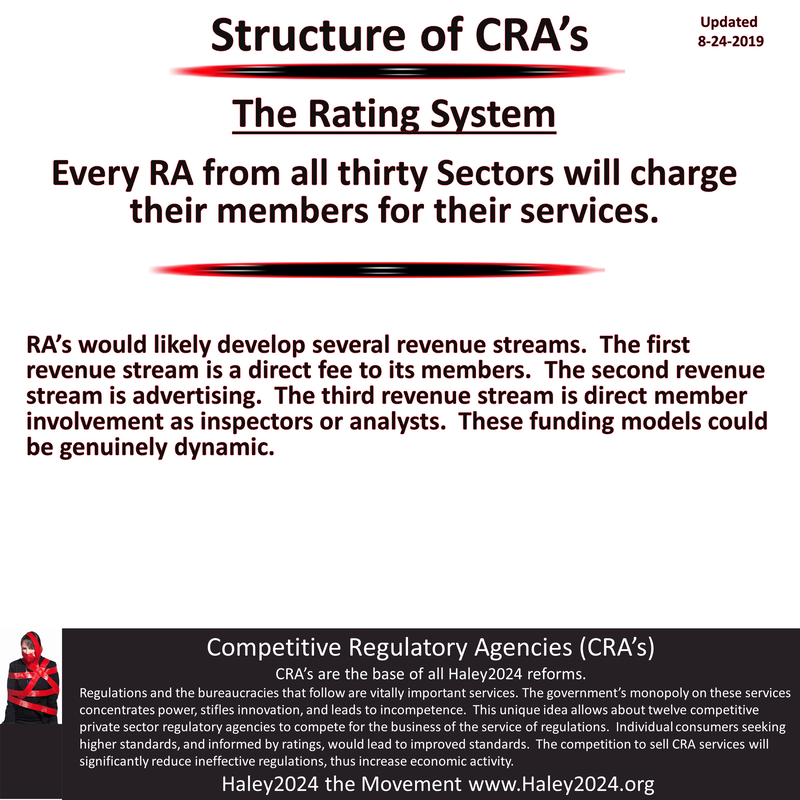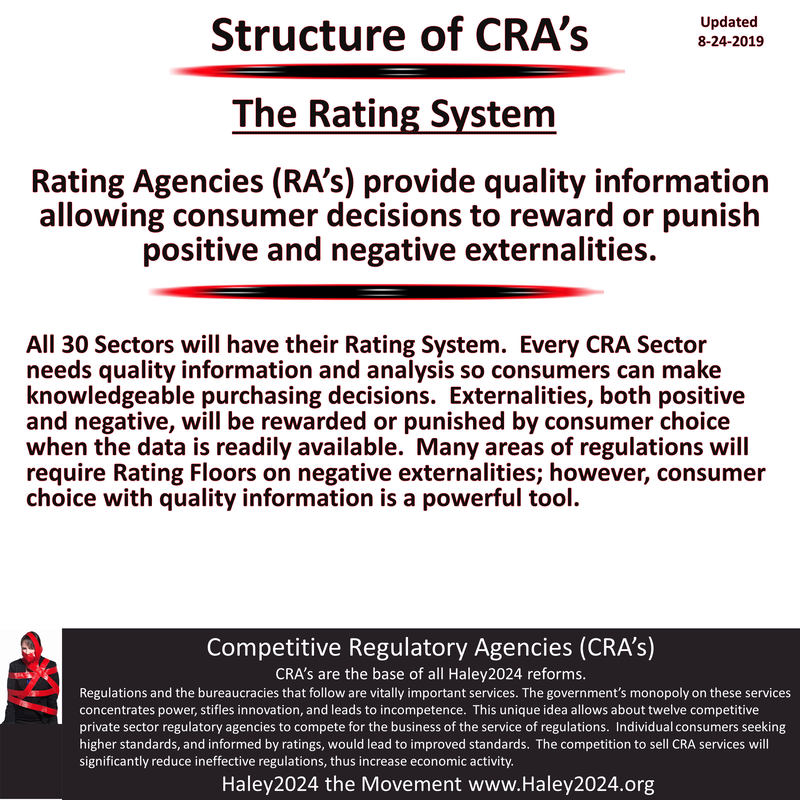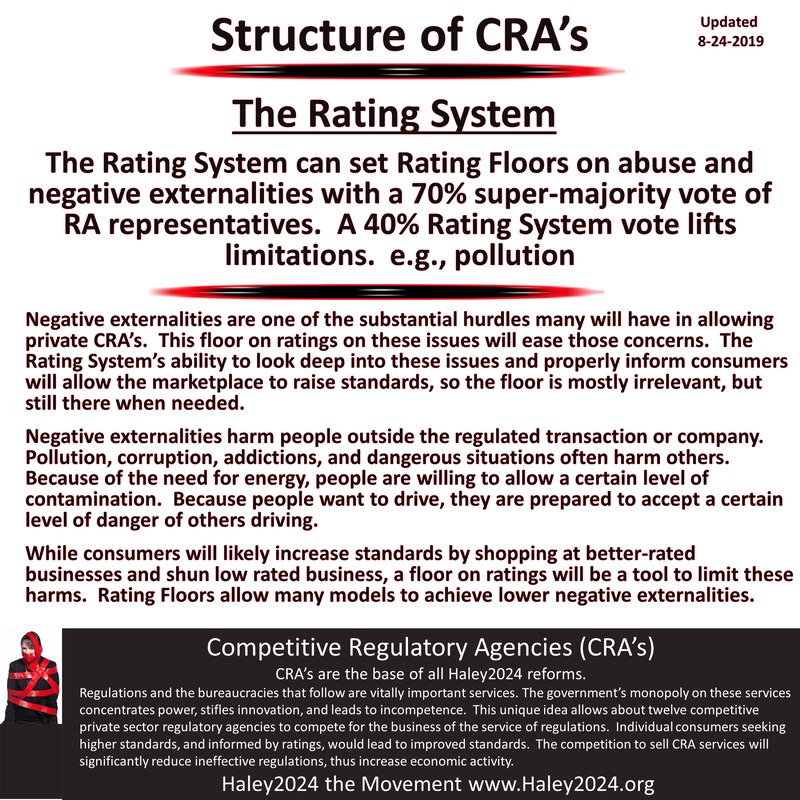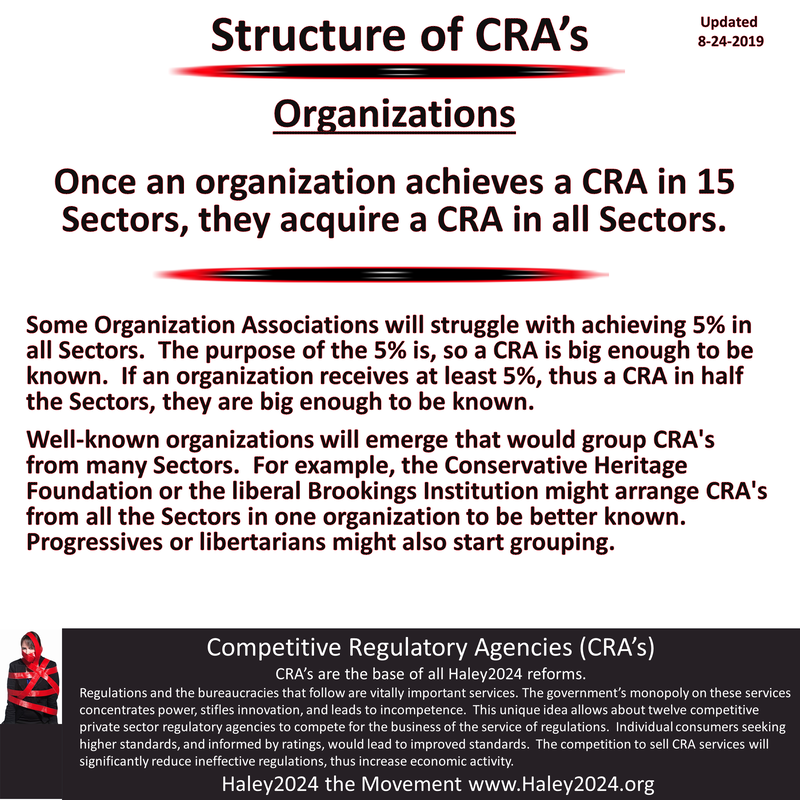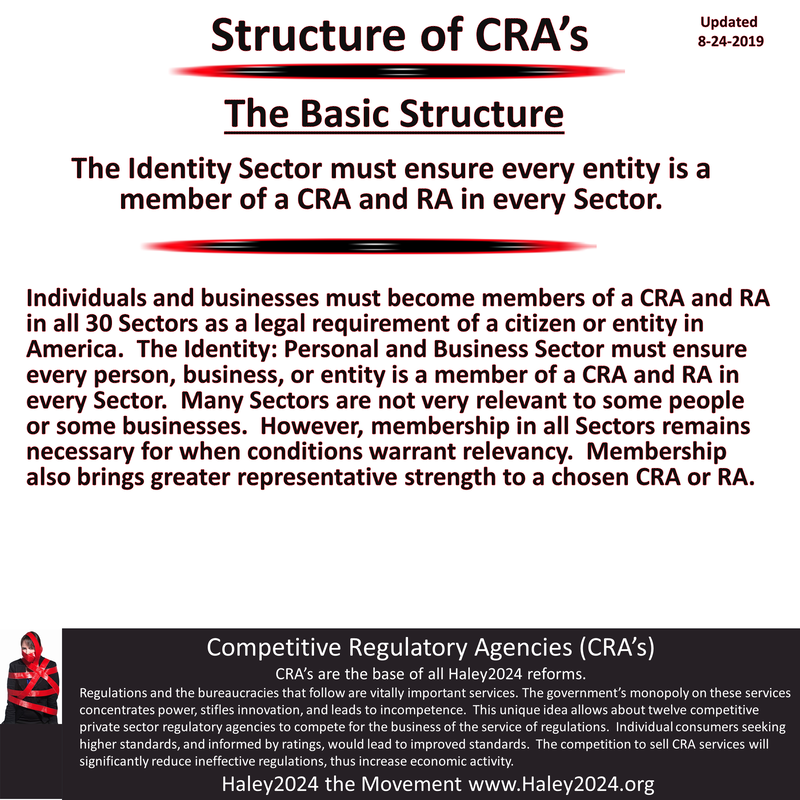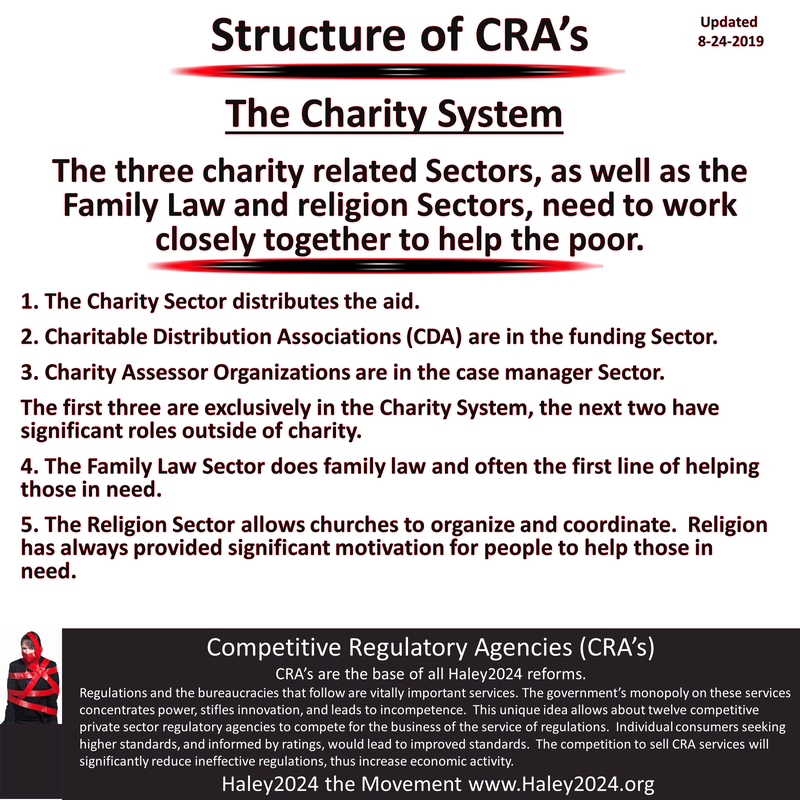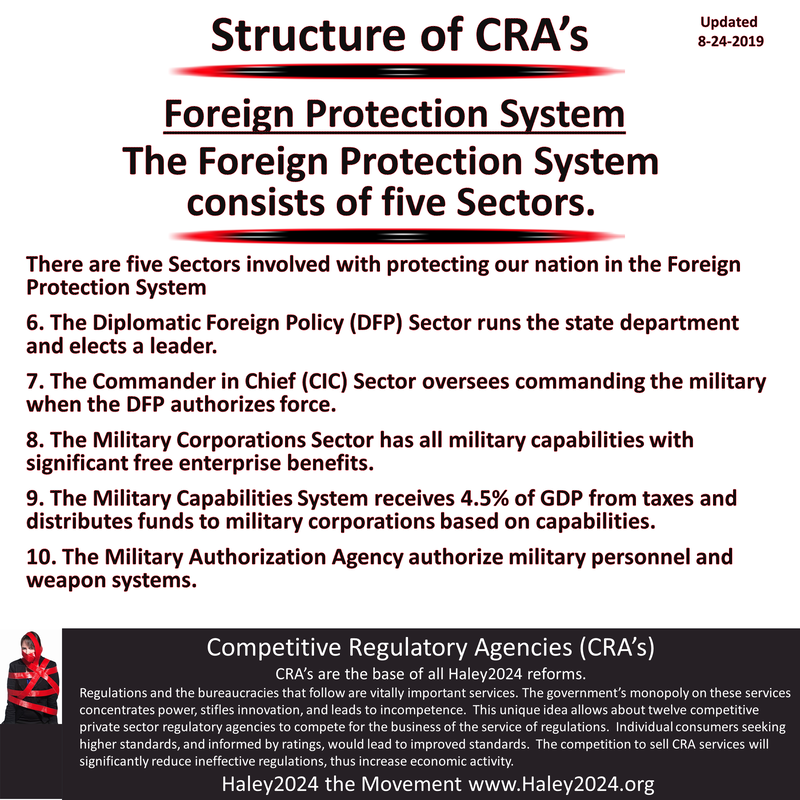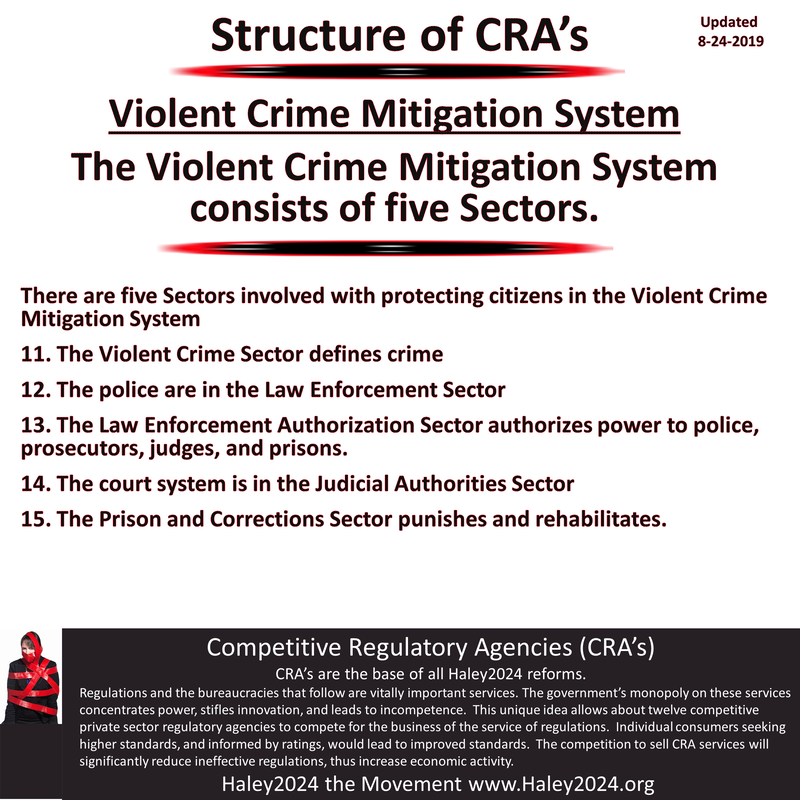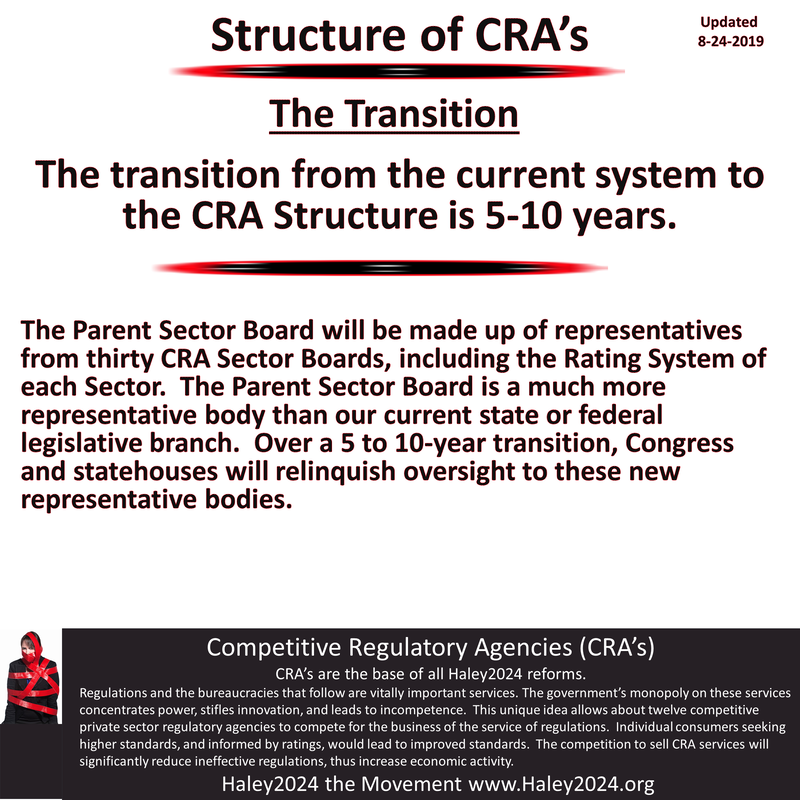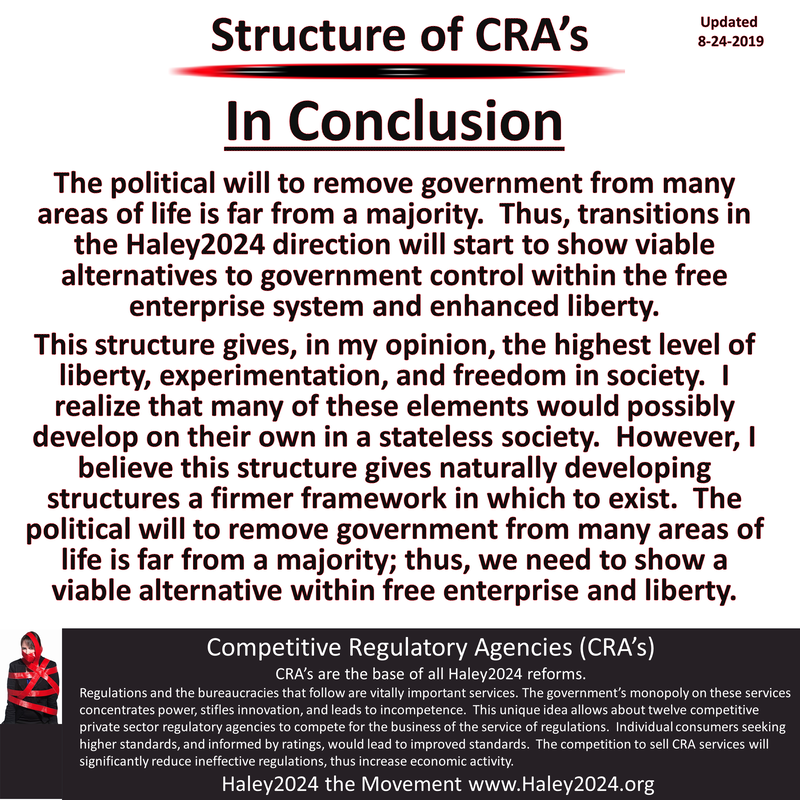The Structure of Competitive Regulatory Agencies
Updated 9-12-2021 version above
These explanations were created 8-24-2019. The basic structure remains; however, small modifications were made to correct inconsistencies or to address conflicts.
This page is designed to give short explanations and thought patterns for each of the bullet-points of the structure of CRA’s.
This page is designed to give short explanations and thought patterns for each of the bullet-points of the structure of CRA’s.
|
On the page, Sector Boards of CRA’s, there is a more significant explanation of all thirty Sectors. All the Sectors mean, everything currently regulated, owned, or otherwise controlled by the government. If a current department is not listed, it will fall under one of these 30 Sectors listed. It is also wise to look at the page with the proposed US Constitutional Amendment creating the CRA Structure.
There will be many turf wars; however, after considerable study and discussion, the Parent Sector Board determines the number, the name, the nature, and the boundaries of every Sector Board. 30 Sectors is a nice balance of too few and too many Sectors. All Sectors are subject to the full CRA Structure. |
The bullet points above was updated 4-25-2020.
|
CRA’s are the base of all Haley2024 reforms.
This CRA Structure will be the basic structure of the economy, businesses, law, organizations, among other entities. This new structure is a switch from the control of elected politicians to greater liberty and freedom, creating many experiments and examples compared to the current system. This structure allows the marketplace to impose most of the limitations to appropriately and efficiently limit negative externalities.
|
|
All government power is separated into 30 Sectors with distinct leadership per Sector.
Every law and regulation will be assigned one of the 30 regulatory Sectors. The nature of each Sector is profoundly different; however, this same CRA Structure is designed to address the full variety of all the Sectors. Specific parts of this CRA Structure and some CRA Sectors are certainly more important to some people and businesses than others depending on many factors.
|
|
Switching representation from electing individuals to selecting governing agencies
Every citizen selects a governing agency that closely resembles their governing philosophy. Citizens would have about a dozen CRA options. The notion of representation is enhanced when everyone is represented by an agency that is selected based on their positions on the issues. Electing individuals are almost entirely a binary choice leaving a sizable minority without representation from their first pick. A sizable percentage of voters on the winning side of the election considers their vote as picking from the lesser of two evils. In the CRA Structure, governance mostly occurs within the chosen CRA.
The policy of ‘one person-one vote’ does not change by switching to selecting agencies. When selecting agencies, every vote WINS. Agencies represent every citizen that selected them. An agency attaining a citizen’s trust/membership gains proportional strength in voting as representatives. Most candidates do not come with long-term policy positions and reputations that citizens can trust. Agencies should be able to build solid reputations. |
There is a CRA Sector Board and a Rating System per Sector.This is a division of power and authority. The CRA is clearly the stronger of these two systems. CRA’s regulate, and the Rating System gives high-quality information. The Rating System can set Rating Floors on CRA’s as described below and authorizes the Sector Board’s level of authority.
|
There are roughly a dozen CRA’s per CRA Sector Board.The structure of CRA’s encourages roughly a dozen CRA’s per Sector. A dozen CRA’s allows enough options that almost everyone has at least one CRA that comes close to their preferred regulatory framework and philosophy. Having every CRA compete for every person’s business creates a system that drives out detrimental and hostile regulations. Advancements in proper and reasonable regulations will be continual.
|
There are roughly a dozen Rating Agencies (RA’s) per Rating System.The American people have a diverse set of opinions on the proper regulations, and they also have a varied collection of views on the appropriate outcomes. Some RA’s will only look at first-order effects, while others will consider second and third-order effects. Some RA’s might value human flourishing as the highest value, while other RA’s contemplate other matters as more treasured. All RA’s will concentrate on corruption; however, many will draw the line at different points. RA’s will have different ways to consider the dynamic nature of many systems.
|
The three levels of federal, state, and local governments each have a distinct full CRA Structure.The city or county level of government will have a complete CRA Structure. The state-level of government will have a complete CRA Structure. The Federal government will have a complete CRA Structure. Each Sector would determine local responsibilities. Each Sector would determine state responsibilities. Each Sector would have federal responsibilities.
|
Every person and business (every entity) must become a member of a CRA and RA in all 30 Sectors and at all three levels.The Haley2024 CRA Structure creates a citizen-owned model of government in America. Citizens, businesses, organizations, or any other entity as a legal requirement must be based in a locality, a state and in America. A legal obligation of being a citizen or other entity in a locality is becoming a member of a CRA and a member of an RA in all thirty local-level Sectors.
A legal obligation of being a citizen or other entity in a state is becoming a member of a CRA and a member of an RA in all thirty state-level Sectors. A legal obligation of being a citizen or other entity in America is becoming a member of a CRA and a member of an RA in all thirty federal-level Sectors. Yes, this does mean 180 memberships. No, this does not increase government powers. Every person or entity can switch CRA’s at their will, subject to reasonable CRA contractual timeframes. Membership in a CRA is a two-party consent agreement; therefore, CRA’s do not need to accept or can reject an application for membership. |
Each CRA governs its members.It is important to note that when you select a governing agency, you choose the CRA that will govern you. Your neighbor decides to select another CRA, and your neighbor is governed by their CRA. If the authority is at the CRA level, your CRA enforces the laws and regulations they create. Your neighbor’s CRA regulates and enforces its policies on your neighbor.
A business is a separate entity from an individual. The owner of the business must pick a CRA in every Sector to regulate their business. The five restaurants near the mall will likely have five different sets of CRA’s regulating them. |
80% of governance will occur in each entity’s selected CRA.24 of the 30 Sectors will have original authority at the CRA level. These 24 Sectors only move limited and well-defined authority to the Sector Board level if 70% of the Rating System claim there is a negative externality that cannot be addressed by Rating Floors and quality information to consumers. 70% of CRA representatives must then vote to accept authority at the CRA Sector Board level. It is unlikely that much authority will reach the CRA Sector Board level.
|
20% of governance will occur by representative control at the Sector Board level.Six Sectors will have principal authority at the Sector Board level. The Diplomatic Foreign Policy (DFP) Sector is the diplomatic Sector dealing with America’s communication with other countries. The Commander in Chief (CIC) Sector commands America’s military. The Military Capabilities System (MCS) Sector funds the military. The Military Authorization Agency (MAA) Sector authorizes military forces to operate.
The Violent Crime (VC) Sector defines the limitations of violent crimes. The Law Enforcement Authorization (LEA) Sector authorizes the police, judges, prosecutors, prisons, among others. By the very nature of these Sectors, society needs to speak in one voice, thus using representatives deciding and a leader executing. |
The Basic StructureThe basic structure is created to provide many checks and balances. The representation of every citizen is enhanced when the CRA they select in all the sectors governs them. The division of authority far exceeds the current government. This structure creates a profound competition of governing organizations to serve each citizen. This Basic structure naturally rewards and punishes positive and negative externalities.
|
Each CRA and RA (Rating Agency) must be between 5% and 20% of their Sector, thus roughly a dozen per Sector. If membership drops below 5%, they must merge; if membership tops 20%, they must split.Having balance with everything is essential. The low 5% side is so people can have proper knowledge of CRA’s. The higher 20% side is to stop regulatory monopoly. This range results in roughly a dozen CRA’s in each Sector Board. If a popular CRA attracts more than 20% of the people/businesses, the CRA will split with each of the two CRA’s competing to attract the current members.
If a CRA loses enough members to drop below 5%, they must shut down, and the remaining members join other CRA’s. The percentages will be a balance between the number of businesses and the size of the businesses. With Rating System input and oversight, each Sector will determine how to measure percentages of the Sector. |
Members of CRA’s and RA’s pick their CRA/RA leadership.CRA’s and RA’s attain their authority to exist by having at least 5% of the owners of the country as members. These owners also must have the authority to pick the leadership of their CRA and their RA. Since CRA members elect CRA leadership, they are very representative of their members. It is to be expected that like-minded members would join the same CRA or the same RA. The leadership votes are likely to be on competency and not on policy preferences. Policy preference issues would likely show up in CRA membership changes.
In the current system, if a citizen activist works hard to move voting strength from 30% to 45%, his side still loses and is without representation. If the activist pushes voting over the 50% mark, he wins representation, and the other side now is without representation. Proportional strength from selections of CRA’s and RA’s allows everyone to have representation. An activist moving selection strength means a change in representational proportional strength. |
CRA’s and RA’s determine the timeframe of service of their leaders and representatives.Current representatives serve for 2,4, or 6-year terms. The Haley2024 CRA structure gives full authority to every CRA and RA to determine its leadership’s and representative's length of service. Some CRA’s and RA’s might set terms, and others will serve at-will. Every agency will have a governing document setting out how their organization will function. How Are Representatives and Leaders Chosen or Elected?
|
Members pay the costs of their CRA in all Sectors. Specific Sectors receive funding from taxes collected from other Sectors.When membership comes with a direct cost, members will demand to be served. The competition of roughly a dozen regulatory agencies competing for members will create incentives for the best governing services. Lower cost could yield decreased services, and higher membership fees might result in higher quality services. CRA’s provide a service that has expenses, and that expense needs to be paid by the members. The phrase “you get what you pay for,” will be very applicable to CRA membership.
CRA’s will start to have reputations and branding. The members of that CRA will have a valuable interest to maintain or enhance that branding. Thus, they will have an interest in electing good leadership of their CRA. Anyone not happy with the direction of their CRA has the right to switch to another CRA. |
CRA’s send representatives to their CRA Sector Board and the CRA Parent Sector Board proportional to their membership.Every American owner needs to be part of the societal oversight of America, their state, and their local government. That oversight starts with sending representatives to all the representative organizations with governmental authority. Every American’s membership gives their CRA more representative power because CRA representatives are proportional to membership. Moreover, citizens get their preferred representative in every Sector.
These representatives would represent and protect their members' interests and rights at the Sector Board level and Parent Sector Board. The Parent Sector Board is quite possibly the most representative body possible. Every citizen has thirty choices per level of government. Every decision enhances the interests and opinions of each citizen. |
RA’s send representatives to their Rating System and the RA Parent Sector Board proportional to their membership.
The primary job of an RA is to provide high-quality information. However, RA’s send representatives to the Rating System at the Sector Board level and to the Rating System at the Parent Sector Board. Representatives can set Rating Floors that limit CRA’s from creating regulations that allow a high level of negative externalities. The Rating System representatives also create the standards for proper posting of rating scores.
Creating proportional representation gives power to each citizen. Every citizen's choice of a CRA and an RA make their CRA and RA more influential. CRA’s and RA’s that have more members also have more representative strength. There is strength in numbers, and every citizen feels empowered when their choices matter. People are less likely to have a call to arms when their selections of CRA’s and RA’s has real power to make a difference. |
Sector boards Sector Boards manage CRA’s and RA’s in their Sector with minimal powers. The Sector Board’s authority and responsibilities are mostly organizational.Other than the six Sectors with primary authority at the Sector Board level, the representatives at the Sector Board level would have minimal authority. The CRA Sector Board would have the authority to ensure a CRA is staying within their jurisdiction and meeting their responsibilities. A Sector Board would fight with other Sector Boards over jurisdictional lines such as where insurance regulations stop, and financial regulations begin. The Parent Sector Board decides the boundaries.
Some Sectors will have limited authority at the Sector Board level. Likely, the Sector Boards would just ensure each CRA in its Sector raises regulatory standards to meet the issue. The Sector Board, with judicial oversight, can dissolve a CRA if they cannot meet the necessary standards, or stop corruption and abuse. Sector Boards will ensure every CRA in their Sector is doing their job and staying within the basic structure. The Sector Boards will help coordinate with the Rating System and other CRA’s. The Sector Board will be involved in reducing negative externalities within their Sector. |
The Parent Sector Board decides the boundaries of all thirty Sectors.The Insurance Sector overlaps with the financial Sector. The human Resources Sector overlaps with worker safety. Is a medical device company, healthcare, or manufacturing? There are many overlaps between Sectors. However, the Parent Sector Board will determine the lines of what Sector has regulatory authority. Every business must be part of all 30 Sectors, even if some are minor.
|
Judicial AuthorityEvery CRA and every CRA Sector Board has judicial authority. CRA’s and CRA Sector Boards have the legal authority to enforce their laws and regulations. CRA’s and CRA Sector Boards use law enforcement regulated by Sector 12 and authorized by Sector 13. CRA’s and CRA Sector Boards use courts and prosecutors regulated by Sector 14 and implement punishment through companies regulated by Sector 15.
All contracts, economic activity, ownership, and almost everything MUST occur under the jurisdiction of a CRA. Everything currently occurs under the jurisdiction of the current government. If there is a dispute, people take the case to court. There is the full realization that there is currently private arbitration; however, state government law has those provisions. Similarly, everything will happen under the jurisdiction of a CRA. Every judicial CRA will compete for everyone’s business of dispute resolution. |
CRA’s encompass every law and regulation. Every CRA decides their regulations and their enforcement of those regulations.Regulations are worthless if there is no accountability. Part of a business’s decision on what CRA to choose is not just their regulations but the enforcement of those regulations. How often and comprehensive are inspections?
What is the arbitration or court proceedings if disputes arise? What are the costs? What are the ratings? Every CRA competing for the business of their service will have to improve their answers to these questions to get the business of people and companies. That competition will yield the proper balance for plaintiffs and defendants. That competition will generate better accommodations and lower transaction cost. Some CRA courts will concentrate on punishment, and others will prioritize restitution. Billions of decisions by millions of people will result in the correct balance, and everyone’s real input to the purpose of justice. |
All contracts, economic activity, ownership, and everything MUST occur under the jurisdiction of a CRA.Everything must fall under the jurisdiction of one of the thirty Sectors. If there is not a negative externality involved, a CRA does not have to regulate it. The enforcement and adjudication of issues that arise will be addressed by the CRA the transaction or contract was under. The buyer and seller or all parties to a contract must decide on a CRA that will have jurisdiction over that sale or agreement.
Many contracts will span many Sectors. Therefore, CRA’s from all relevant Sectors must be involved. Many people will initially surmise that this will cause significant complications that will slow down commerce. Additional thoughts about the competition for the best set of regulations will inform those people that businesses will demand easy to understand and easy to use regulations. The popularity of the one-click purchase will be mirrored in contracts. Ratings will play a massive role in allowing people and businesses to quickly trust a contract or transaction. |
CRA’s and Sector Boards are governing agencies with legislative, executive, and judicial branches.The members of a CRA, not only vote on the representatives to the Sector Board and Parent Sector Board, they vote on the leadership of their CRA. A CRA has three distinct branches. The members of the legislative branch examine its CRA’s governing philosophy and create the laws and regulations in which their members must follow. The executive branch of a CRA administers its laws and regulations only on its members. The members vote on judges for their judicial branch. The judicial branch is regulated by the Judicial Sector.
|
Each CRA decides its level of regulation from very light to heavy.One of the significant benefits to the CRA Structure is that everyone must live under the set of laws that they wish to live under while allowing their fellow citizen to live under their selected set of rules. In some cases, the regulations would be marginal and only address extreme cases. Most people do not want burdensome regulations on their florist yet will demand robust and proper regulations on their pharmacist.
The members have the authority to vote on adjustments to their CRA governing philosophy. If they are getting unsatisfactory results, they can switch to another CRA or try to internally change the CRA philosophy, thus yield better regulations. |
People are free to do business under any CRA, not just their own, with few exceptions.If a citizen is a member of a certain Food CRA, they are not forbidden from going into a grocery store regulated by another food CRA. A citizen can have accounts at multiple banks, regulated by different Financial CRA’s. A citizen can work in many Charity Economies regulated by different Charity CRA’s. A citizen can have two jobs that have different Work Safety CRA’s. A citizen can own two businesses with a totally different CRA portfolio. A citizen can own stocks in many military corporations.
For the most part, citizens will use their own CRA when selling; however, when they are the buyer, they will fall under the jurisdiction of the business doing the selling. CRA’s competing for the business of regulations will likely have excellent cooperation with other CRA’s. |
The Law Enforcement Authorization (LEA) Sector has the responsibility of authorizing the authority to the police, judges, prosecutors, prisons, among others.One of the significant issues that concern many people about private police is that of representative oversight. Representatives of the people must give law enforcement officers, prosecutors, and anyone that has inherent power over others, that power.
These LEA representatives at the Sector Board level determine the qualifications, however, are likely to include training, experience, good ratings, respecting civil liberties, among other factors. There will be many layers of authorizations, such as neighborhood guard, patrolmen, detective, and master detectives. |
The Military Authorization Agency (MAA) Sector has the responsibility of authorizing the authority to everyone involved in the Foreign Protection SystemOne of the significant issues that concern many people about the private military is that of representative oversight. Representatives of the people must give military officers, enlisted men, and anyone that has inherent military powers, that power. This moves towards societal oversight and away from government control.
70% of the representatives of the people must approve everyone in the entire Foreign Protection System. 40% of the representatives of the people have the authority to strip that authority away from anyone in the Foreign Protection System. Everyone in the Foreign Protection System must swear allegiance to America, the MAA, the CIC, and the DFP. Everyone in the Foreign Protection System must learn the proper jurisdiction, responsibilities, and authorities of each Sector and its leaders. |
The Sector Board provides the first level, and the Parent Sector Board provides the second and top level of appellate court oversight.The CRA level courts are the trial courts. All court cases start at the CRA level. Most courts would have authority across many Sectors so disagreements that span many Sectors would be able to be addressed in one court. These judges would also be able to handle most cases across different CRA’s. CRA’s would compete to have their case-law very clear and understood.
The Sector Board level would be appellate courts and only handle issues of abuse, corruption, and misapplications of the law. The Sector Board level would ensure civil liberties are respected and not infringed by the courts or law enforcement. The Parent Sector Board court system would be the top level of the judicial system; however, would have limited authority. The Parent Sector Board court system would determine issues of what Sector has jurisdiction and what CRA has jurisdiction. The Rating System at the Parent Sector Board level must vote at a 70% level to send a case to the Parent Sector Board court system for issues of abuse, corruption, and misapplications of the law. |
Sector 25 regulates intellectual property.Intellectual Property (IP) must be managed at the Sector Board level. Every Sector must pick an IP regulatory body to regulate its IP regulations. Sector 25 deals with ownership, so every Identity: Personal and Business CRA must have an IP division. All thirty Sector Boards will set their patent laws with Rating System approval. The thirty separate patent systems will create many experiments and lessons.
|
Free markets will result in a better judicial process.A respectable judicial process is essential. If there is just one system, it lacks key experimentation and examples. If a business goes through an inefficient and unfair process, they will try to avoid that system in the future. Other CRA’s will advertise a better judicial experience. The competition of what CRA every person and every business can do business under will be vibrant.
|
Low ratings from unjust rulings will result in CRA’s losing trust and members.People will avoid the cheaper cost of an insufficient judicial system, similar to avoidance of the lower price of an untrained doctor. Market forces will increase standards. Most people will not trade the low dollar cost to the high frustration cost of inefficient and weak civil liberty protections.
|
The Rating SystemThere will be many that will state that the Rating System is not needed as a requirement because it will develop on its own. While some Rating Systems will develop, the Haley2024’s Rating System comes with representative authority and responsibilities.
The Rating System allows more government power to switch to free enterprise control. It is much more than what might develop on its own. A mandatory Rating System could encourage the political will to transition from politician control to the CRA Structure. |
There is enormous influential power to rate and inform citizens about standards. Roughly a dozen Rating Agencies (RA) split this power.It is well known that the person setting the narrative can influence the results. Ratings are going to be tremendously powerful. That power should never be in the hands of one person or a small group of people. Having roughly a dozen RA’s with different philosophies will separate that power. Every person will give their chosen RA more funding and representative authority at the Rating System level. Every citizen would have a wide variety of perspectives in which to examine.
|
Ratings must be prominently displayed.The purpose of the Rating System is to provide quality information to people before they make a trade or do any economic activity. People will naturally reward better ratings and evade poor ratings. Logically, ratings will be prominently posted on doors, stores, websites, flyers, contracts, employment applications, packaging, and points of purchase. Advertising high ratings and attempts to conceal low ratings is an inevitability.
Smartphone apps are likely for all Rating Agencies. While packaging might have some key rating scores, an app can go in-depth on all the issues. The purpose of having roughly a dozen Rating Agencies competing for every citizen's trust is that everyone looks at problems differently. A dozen ways of looking at a subject provides citizens with many perspectives and quality information. A new store or product with good ratings with the RA that people trust can bring instant trust and business. |
Every person’s membership in an RA brings greater influence and funding on their RA.To have real representation, your representative must represent you and your opinions and policies on the board on which they sit. The current government system has one representative representing everyone within a geographic area.
Under the Rating System, all RA’s list their values and policies, and you pick the closest list that matches your own. You then vote with other like-minded people on your RA leadership. RA’s send representatives to the Rating System by weighted average. Thus, your trust brings more power to your RA. |
Every RA from all thirty Sectors will charge their members for their services.RA’s would likely develop several revenue streams. The first revenue stream is a direct fee to its members. The second revenue stream is advertising. The third revenue stream is direct member involvement as inspectors or analysts. These funding models could be genuinely dynamic.
|
|
Rating Agencies (RA’s) provide quality information allowing consumer decisions to reward or punish positive and negative externalities.
All 30 Sectors will have their Rating System. Every CRA Sector needs quality information and analysis so consumers can make knowledgeable purchasing decisions. Externalities, both positive and negative, will be rewarded or punished by consumer choice when the data is readily available. Many areas of regulations will require Rating Floors on negative externalities; however, consumer choice with quality information is a powerful tool.
|
Trillions of informed decisions by billions of people lead to higher standards.The role of prices is the most essential tool to steadily increase standards. People prefer higher standards on everything; however, realize that increasing standards too high on one thing often creates the need to lower standards on many other things. Most people prefer to steadily increase standards. Society can handle many people at different standards.
The economy is all 7.5 billion people on earth, each making buying decisions hundreds of times a week. The invisible hand of the free enterprise system using the role of prices examines the trillions of decisions made by the billions of people to set prices and distribute goods to everyone. Real-estate brokers commit to higher standards as a Realtor. Businesses pay money and subject themselves to additional regulations to gain the status as a BBB Member. Higher standards attract additional customers. Many other examples of the same are in every industry. The Rating System will reduce information cost relating to the quality of standards. Every Rating Agency (RA) and the RA Sector Board will have as their goal for their ratings to be understood, useful, and trusted. Every Rating System will rate the RA’s under them on those three measures. |
The Rating System can set Rating Floors on abuse and negative externalities with a 70% super-majority vote of RA representatives. A 40% Rating System vote lifts limitations. e.g., pollutionNegative externalities are one of the substantial hurdles many will have in allowing private CRA’s. This floor on ratings on these issues will ease those concerns. The Rating System’s ability to look deep into these issues and properly inform consumers will allow the marketplace to raise standards, so the floor is mostly irrelevant, but still there when needed.
Negative externalities harm people outside the regulated transaction or company. Pollution, corruption, addictions, and dangerous situations often harm others. Because of the need for energy, people are willing to allow a certain level of contamination. Because people want to drive, they are prepared to accept a certain level of danger of others driving. While consumers will likely increase standards by shopping at better-rated businesses and shun low rated business, a floor on ratings will be a tool to limit these harms. Rating Floors allow many models to achieve lower negative externalities. |
CRA Organizations would ‘bundle’ CRA’s and RA’s from all thirty Sectors for convenience and branding.Every person/business can pick and choose any of the CRA’s in all thirty Sectors. However, many will see continuity benefits in staying with an Organization Association group brand. Organization Association groups will have a CRA in every Sector. Thus, they will work together much better.
People and businesses must be in all thirty Sectors and will see significant conveniences if all their CRA’s are under one roof. Many CRA’s will advertise their good working relations with all other CRA’s in different Sectors. This continuity and cooperation will prove to be dynamic and ever improving. |
Once an organization achieves a CRA in 15 Sectors, they acquire a CRA in all Sectors.Some Organization Associations will struggle with achieving 5% in all Sectors. The purpose of the 5% is, so a CRA is big enough to be known. If an organization receives at least 5%, thus a CRA in half the Sectors, they are big enough to be known.
Well-known organizations will emerge that would group CRA's from many Sectors. For example, the Conservative Heritage Foundation or the liberal Brookings Institution might arrange CRA's from all the Sectors in one organization to be better known. Progressives or libertarians might also start grouping. |
Many statism organizations would likely develop; however, they can only affect its members.There are many variations of statism. Organizations will allow extensive statism models because they will control all the relevant Sectors to make the system work. People picking CRA’s that are more statist, thus more controlling will meet the desires of some people. The idea is that they only affect those that choose the statism CRA’s. The statism CRA’s do not have the power or authority to go outside their CRA/organization for funding.
|
The Identity Sector must ensure every entity is a member of a CRA and RA in every Sector.Individuals and businesses must become members of a CRA and RA in all 30 Sectors as a legal requirement of a citizen or entity in America. The Identity: Personal and Business Sector must ensure every person, business, or entity is a member of a CRA and RA in every Sector. Many Sectors are not very relevant to some people or some businesses. However, membership in all Sectors remains necessary for when conditions warrant relevancy. Membership also brings greater representative strength to a chosen CRA or RA.
|
The three charity related Sectors, as well as the Family Law and religion Sectors, need to work closely together to help the poor.1. The Charity Sector distributes the aid.
2. Charitable Distribution Associations (CDA) are in the funding Sector. 3. Charity Assessor Organizations are in the case manager Sector. The first three are exclusively in the Charity System, the next two have significant roles outside of charity. 4. The Family Law Sector does family law and often the first line of helping those in need. 5. The Religion Sector allows churches to organize and coordinate. Religion has always provided significant motivation for people to help those in need. |
The Foreign Protection System consists of five Sectors.There are five Sectors involved with protecting our nation in the Foreign Protection System
6. The Diplomatic Foreign Policy (DFP) Sector runs the state department and elects a leader. 7. The Commander in Chief (CIC) Sector oversees commanding the military when the DFP authorizes force. 8. The Military Corporations Sector has all military capabilities with significant free enterprise benefits. 9. The Military Capabilities System receives 4.5% of GDP from taxes and distributes funds to military corporations based on capabilities. 10. The Military Authorization Agency authorize military personnel and weapon systems. |
The Violent Crime Mitigation System consists of five Sectors.There are five Sectors involved with protecting citizens in the Violent Crime Mitigation System
11. The Violent Crime Sector defines crime 12. The police are in the Law Enforcement Sector 13. The Law Enforcement Authorization Sector authorizes power to police, prosecutors, judges, and prisons. 14. The court system is in the Judicial Authorities Sector 15. The Prison and Corrections Sector punishes and rehabilitates. |
Sectors 6,7,9,10,11, and 13 has original and predominate control at the representative Sector Board level.These Sectors must speak with one voice for the city, the state, or the nation. It is not wise to have multiple authorities in America, speaking to other countries. The Commander in Chief Sector must have control under one Commander. Authorizing police or military power must always be with societal oversight. Distributing funds to military corporations needs one unified system. There must be only one set of violent crime laws.
|
Sectors 8, 12, 14, 15, 24, 25, and 26 have a strong need for Rating Floors from the Rating System as additional controls.Sectors 8, 12, 14, and 15 all have societal oversight from Sectors 10 and 13 authorizing its authority to use governmental powers. Sectors 24 and 25 have the duties of collecting taxes; thus, there is a need to ensure high levels of honesty and integrity. Sector 25 deals with ownership rights and citizenship. The entire country has a vested interest in controlling the granting of citizenship in a citizen ownership model of government. The Environmental Sector would also need a floor to address pollution concerns.
The separate Rating System of each Sector, giving quality information from a dozen different perspectives will apprise citizens which CRA and company is doing a respectable or poor job. A court system might not lose the authority to operate if they move from a rating of 85 to 84 on the 1 through 100 scale, but that drop might lead businesses to seek other better-rated courts in which to do business. A Rating Floor gives a floor in the unlikely event that certain people stop caring about issues with negative externalities. A cop with a badge has the authority to detain other citizens. While it is doubtful that people will hire corrupt cops or that the LEA would authorize a corrupt cop a badge; it is wise to have another mechanism to give a floor on low standards. |
The transition from the current system to the CRA Structure is 5-10 years.The Parent Sector Board will be made up of representatives from thirty CRA Sector Boards, including the Rating System of each Sector. The Parent Sector Board is a much more representative body than our current state or federal legislative branch. Over a 5 to 10-year transition, Congress and statehouses will relinquish oversight to these new representative bodies.
|
In ConclusionThe political will to remove government from many areas of life is far from a majority. Thus, transitions in the Haley2024 direction will start to show viable alternatives to government control within the free enterprise system and enhanced liberty.
This structure gives, in my opinion, the highest level of liberty, experimentation, and freedom in society. I realize that many of these elements would possibly develop on their own in a stateless society. However, I believe this structure gives naturally developing structures a firmer framework in which to exist. The political will to remove government from many areas of life is far from a majority; thus, we need to show a viable alternative within free enterprise and liberty. |


